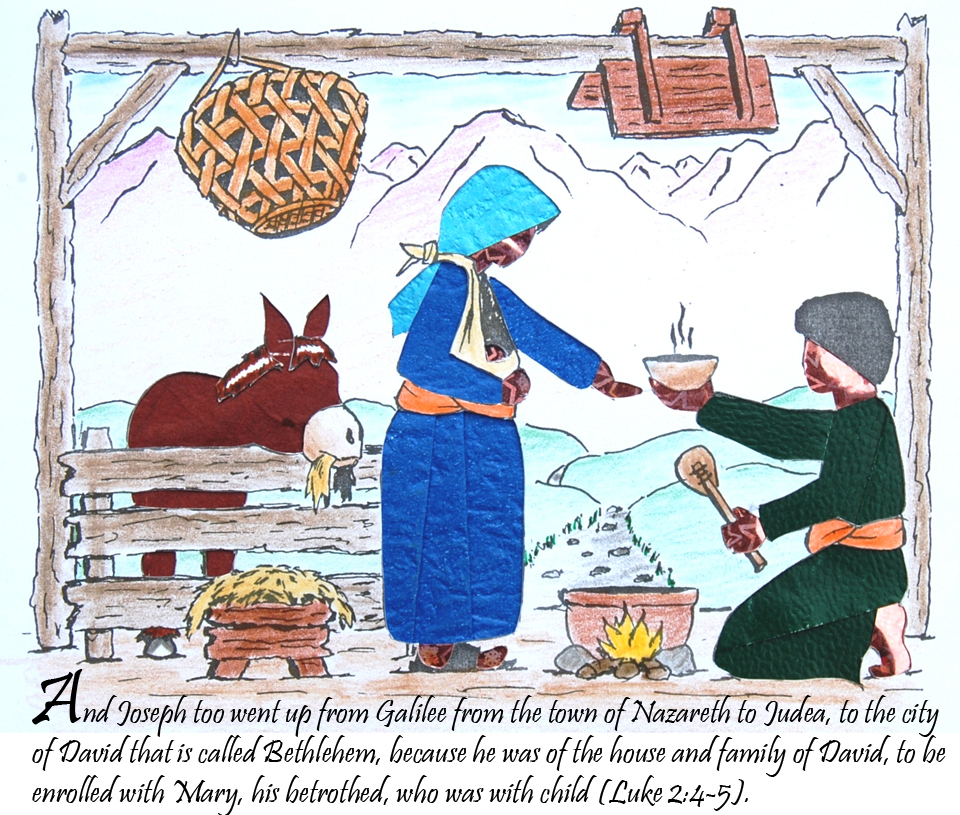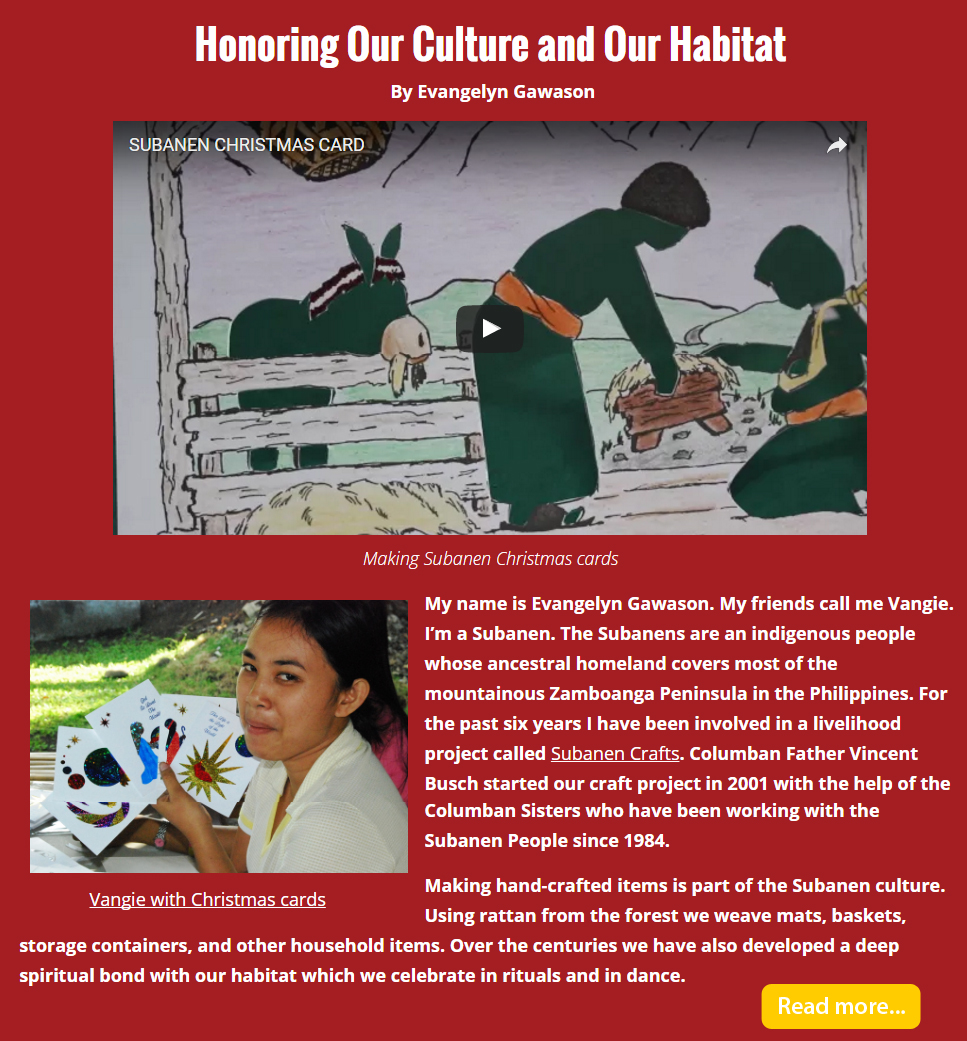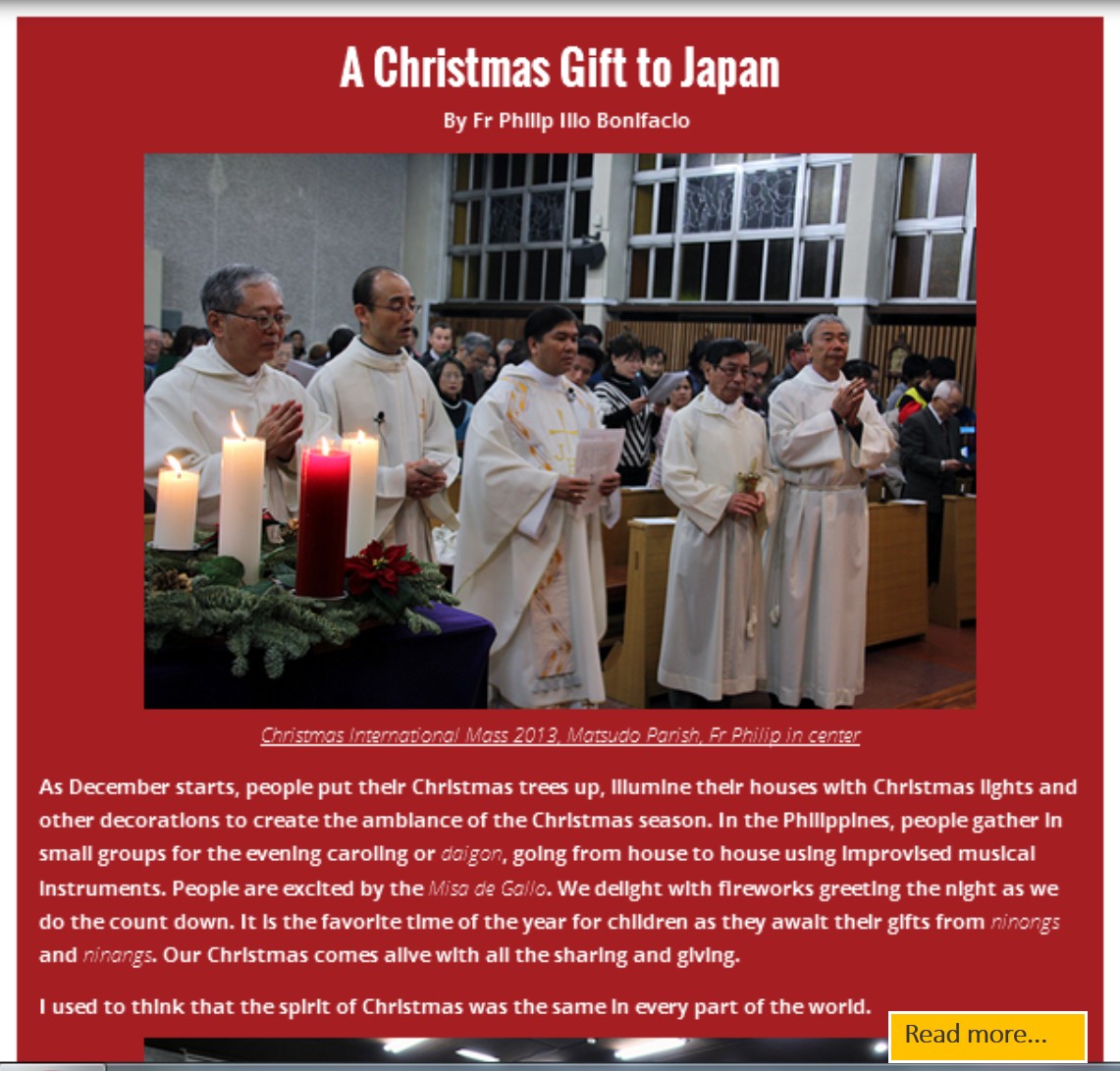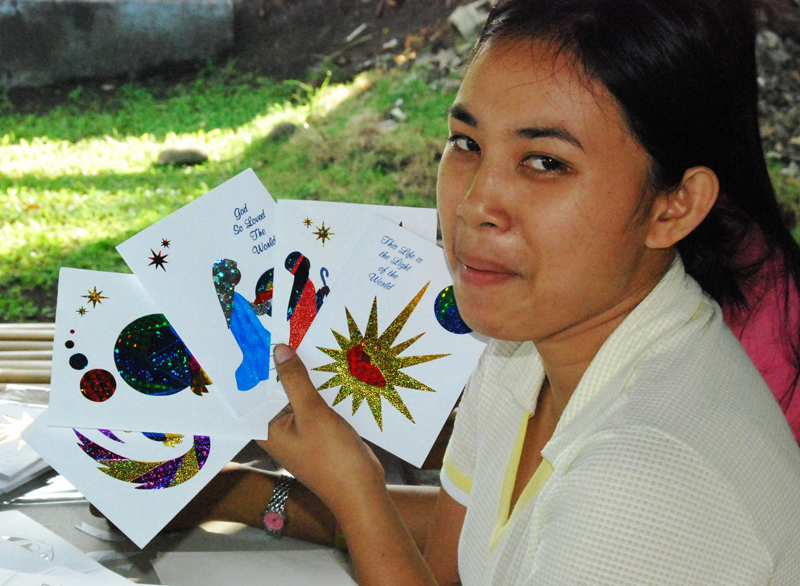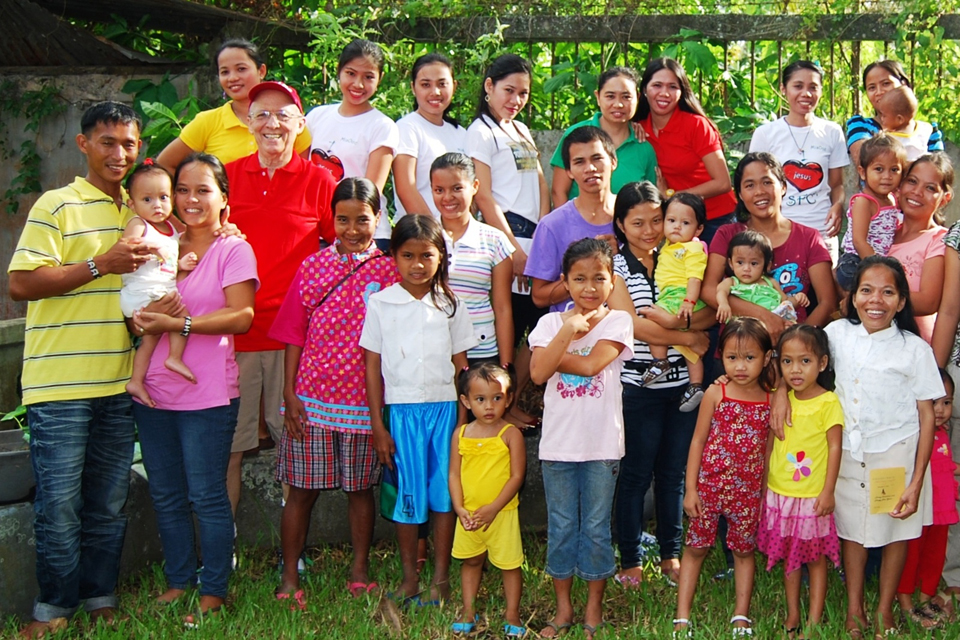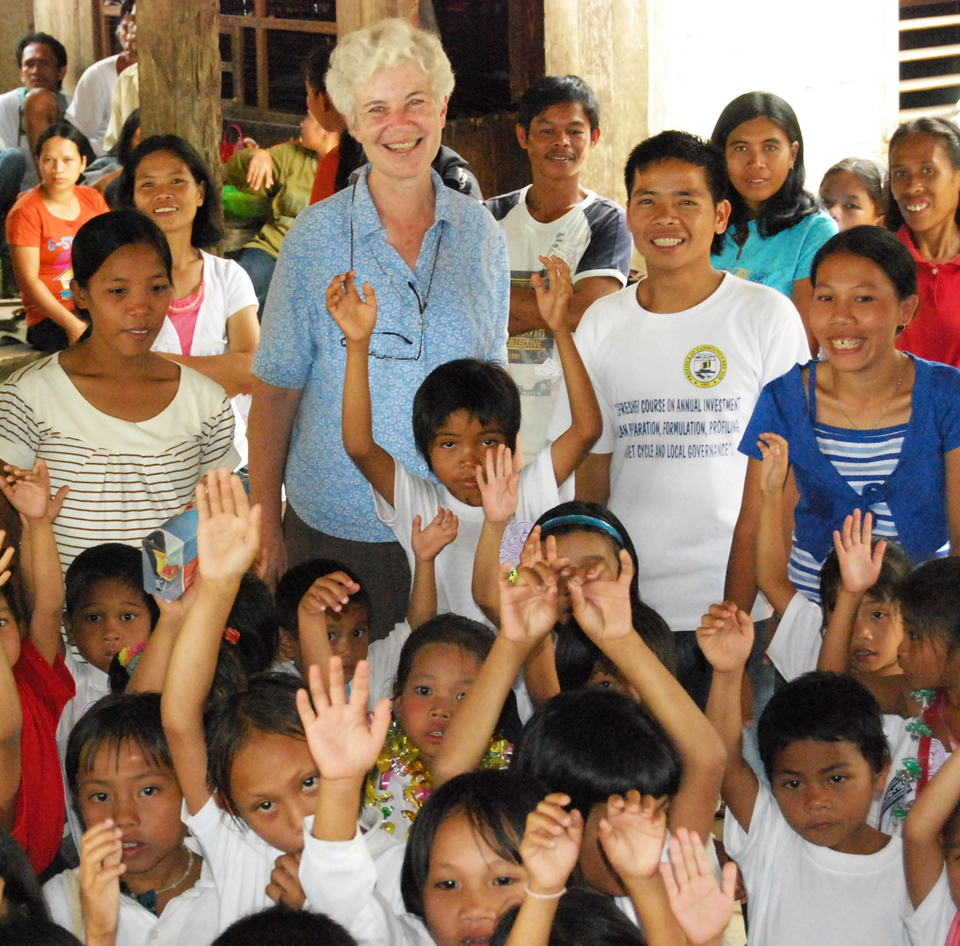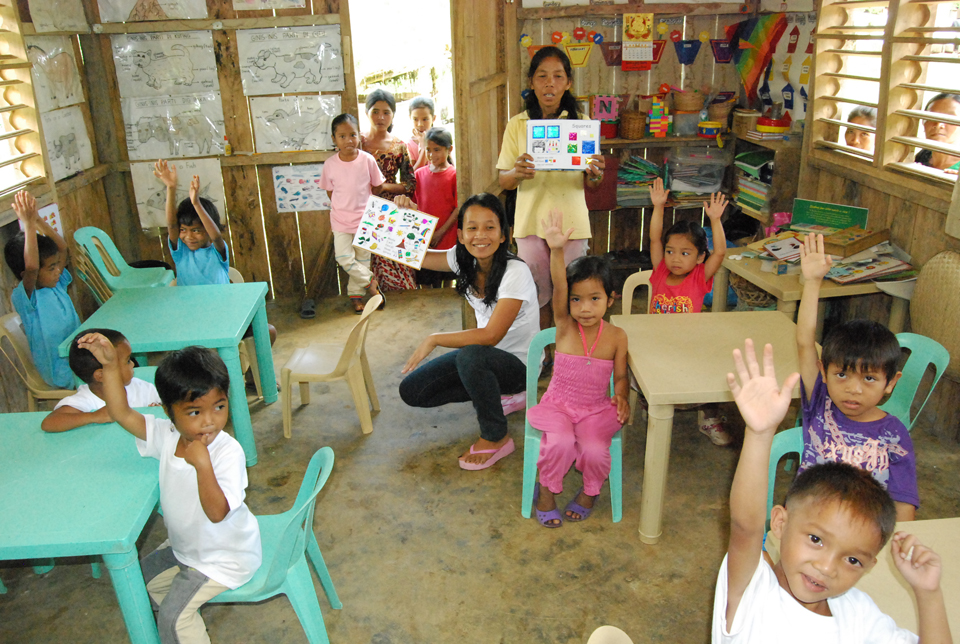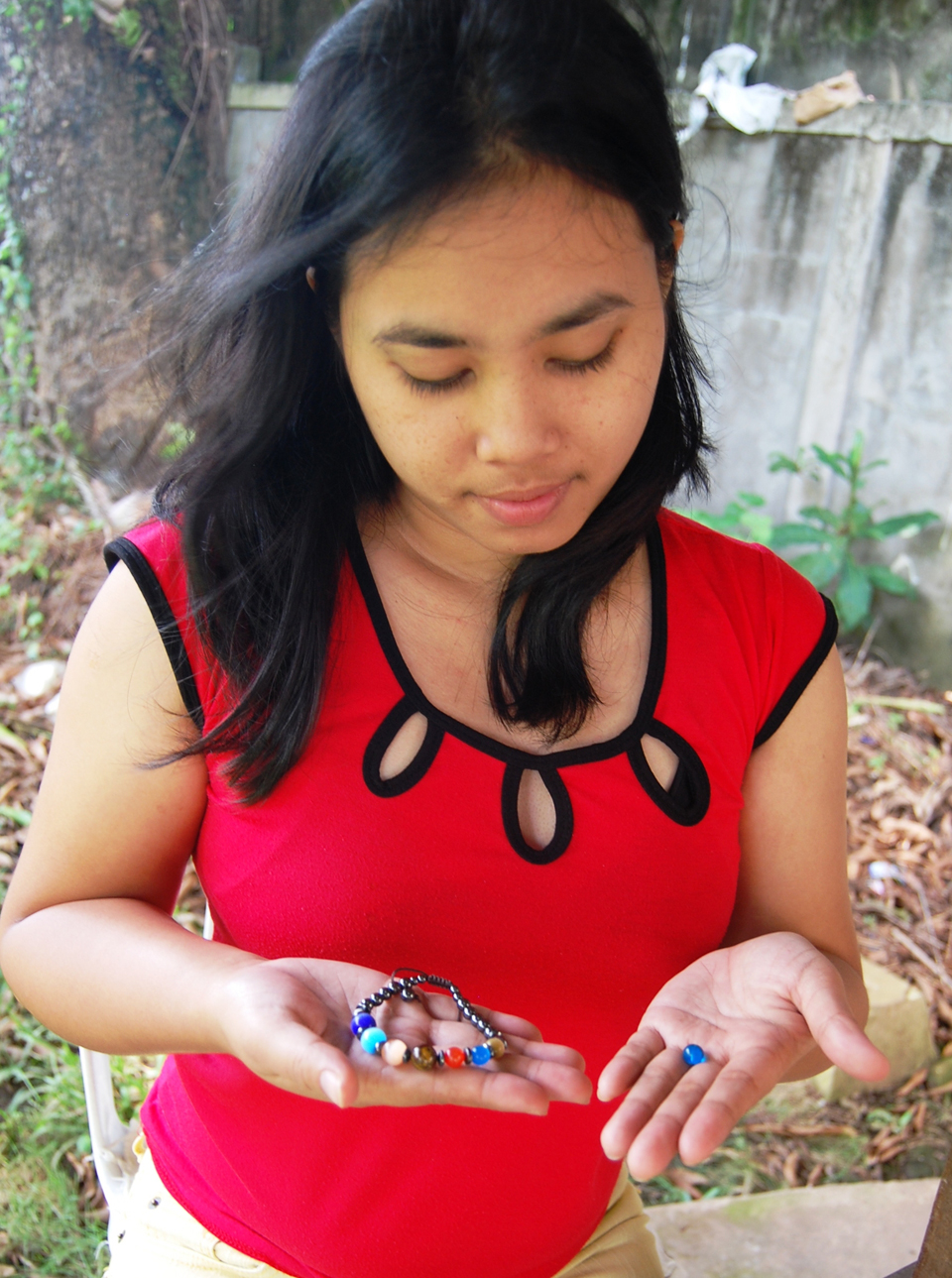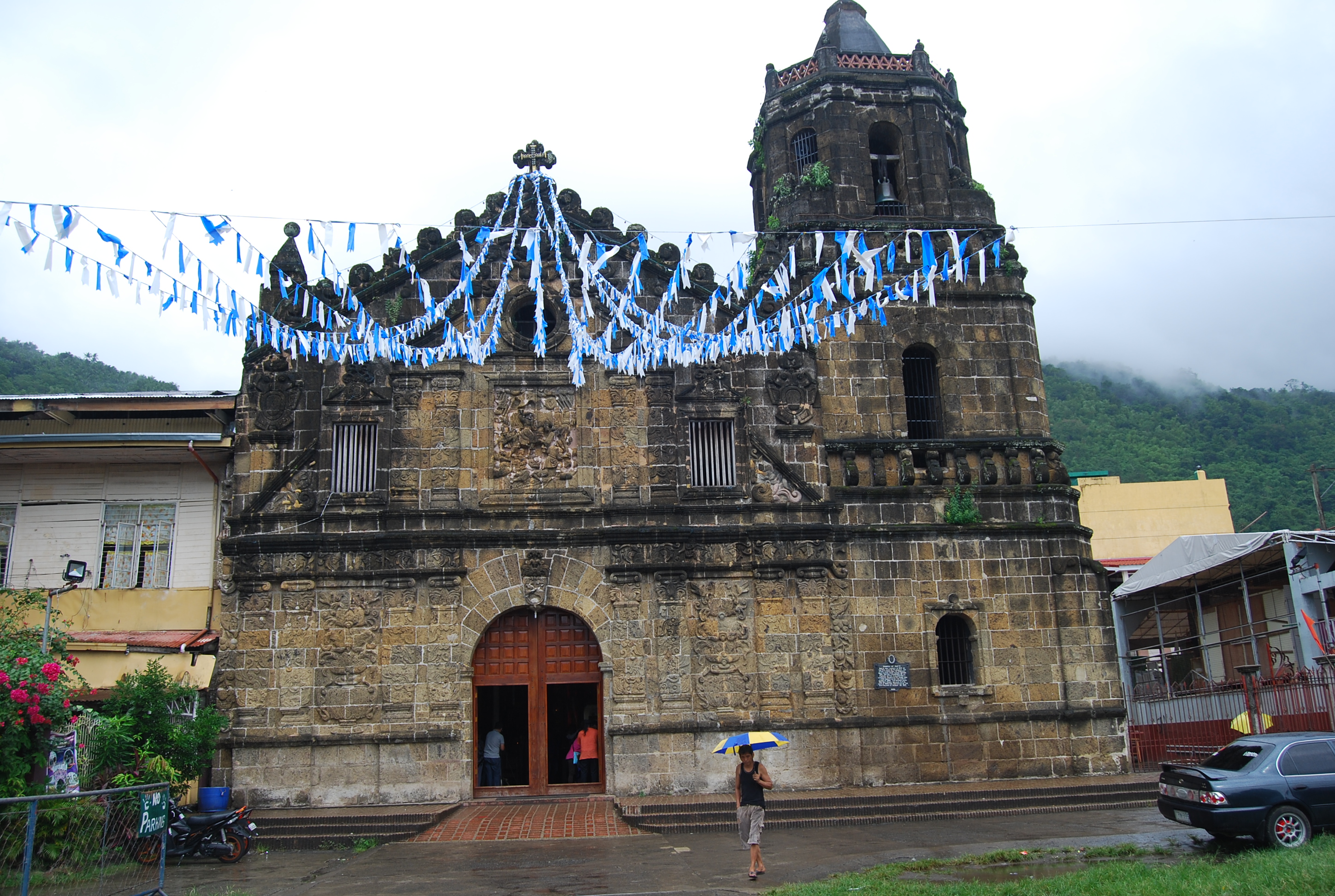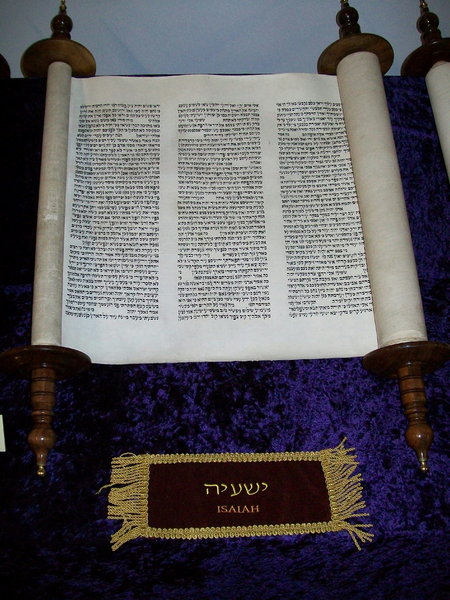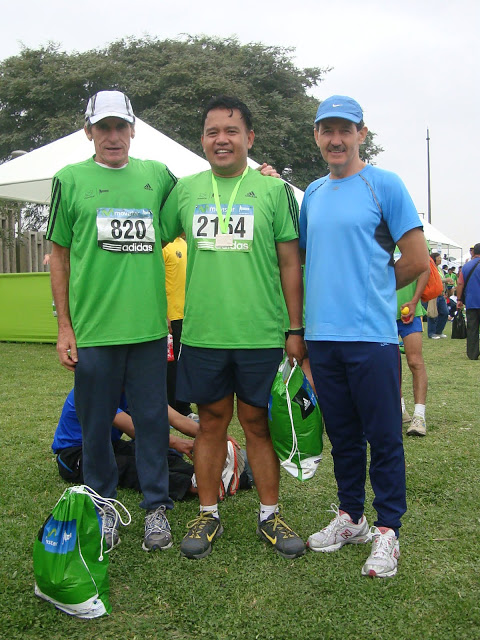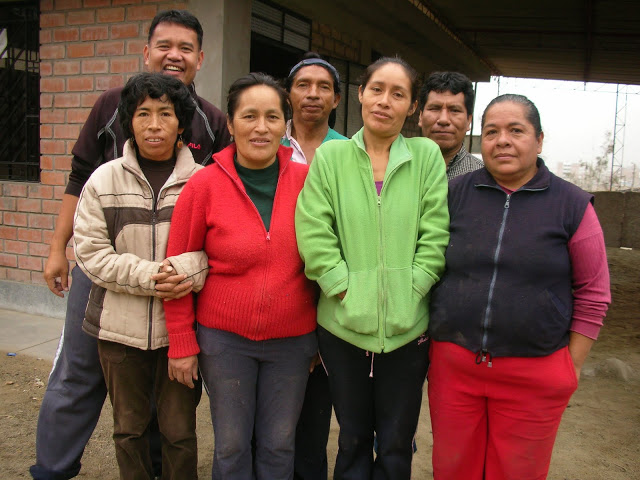Misyon Online - November-December 2016
Christmas 2016
An old story that’s always new
An old story that’s always new
A reflection for International Migrants’ Day, 18 December
By Fr Bobby Gilmore

Rest on the Flight into Egypt, Gerard David [Web Gallery of Art]
Joseph rose and took the child and his mother by night and departed for Egypt. He stayed there until the death of Herod. (Mt 2-14-15).
The image of Joseph, Mary and Jesus sitting in the shade of a tree with their donkey tethered to a branch outside some Egyptian town all those years ago is repeated almost daily in newscasts. The plight of Syrian, Iraqi, Libyan and African families fleeing for their lives across water, desert and mountain with a few belongings is reminding us that little has changed for millions of men, women and children. Daily we see the terror in their faces as they scramble aboard rickety boats, reach a Mediterranean beach and then a border crossing secured by military armed with assault rifles.
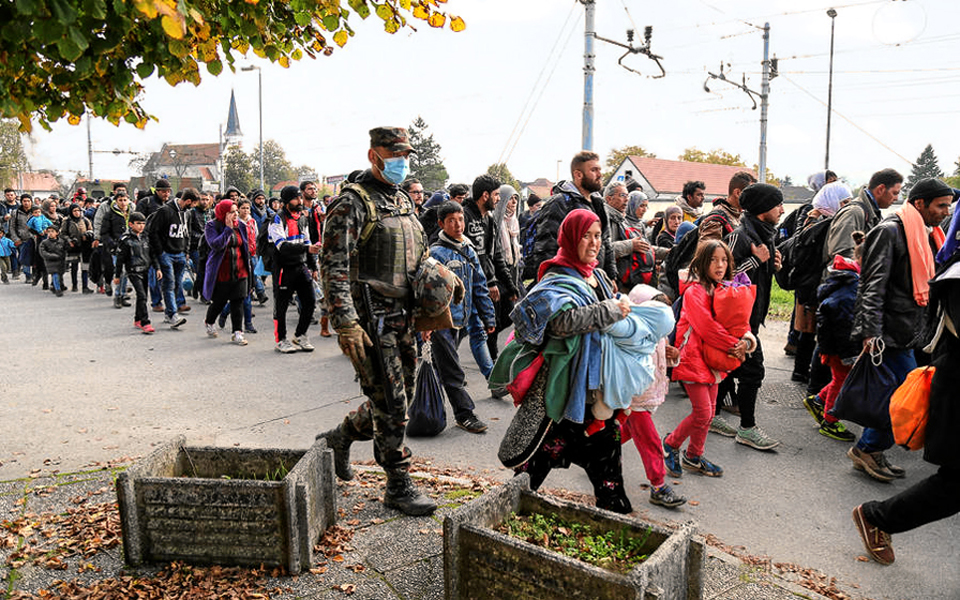
Syrian refugees passing through Slovenia, 23 October 2015 [Wikipedia]
Worse still is the anxious face of a woman guarding her children as their father is handcuffed by border police in Hungary. The anxiety on her face resembles that of Mary under the tree in Egypt, the Jewish children arriving at Liverpool St. Station waiting to be given a home by an English family, the men, women and children on the St Louis in Havana in 1939, the woman and children on Route 66, the Vietnamese woman and children tossed around in a boat in the Pacific, the woman and children at the US-Mexican border fence, the women and children in a refugee camp in Turkey, Lebanon or Jordan, the woman under a tree in the Sahara, the pregnant woman in the camp at Calais, the father of the dead child on a Greek beach, a woman and children waiting to board a bus in a European railway station, the face of the woman and children at the Migrant Rights Centre in Ireland.
From Aid to the Church in Need
It is hard to accept 2,000 years after the flight of Joseph, Mary and Jesus into Egypt that people are running for their lives from the same part of the world today. But more disturbing is the impotence of present world governance to prevent this from happening. Never are there more resources at the disposal of governments to accommodate desperate people who have to flee. Yet, with some exceptions, the application of these resources is found wanting in responding to basic human shelter and safety.
When it comes to making resources available in preparation for war there seems no shortage or lack of military management. And it is precisely the misuse of these military and associated corporate resources initiating and maintaining war and conflict that are causing the human deprivation we see on the faces of people today. How come that the management expertise evident in military expeditions cannot be used to manage human desperation, the residue of war?
The present exodus from the Middle East and Africa didn’t happen overnight. It was predicted years ago by Susan George in her book, The Debt Boomerang. While great progress has been made over the latter half of the last century and in the early years of this century the care of the weak and the dispossessed has become an irritant. Frequently, tabloid media headlines highlight the weak, immigrants, refugees as swarms of scroungers.
Children document life in largest Syrian refugee camp
They are animalized, corralled in 'jungles' of despair, treated with indifference at the drawbridges of European fortresses. Europe has developed a sanitized memory of its post- and pre-war exodus of people looking for safe havens around the world. Echoes of the pre-Second World War Evian conference are heard around Europe today as nations threaten to close their borders to those seeking refuge.
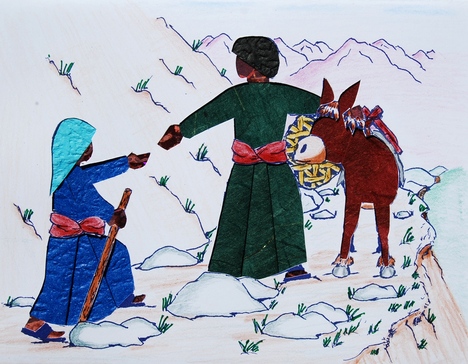
St Joseph helping Mary on the journey to Bethlehem [ Subanen Crafts]
Immigrants and refugees, just like Joseph, Mary and Jesus, do not want to leave home and familiar surroundings. Television images of destruction in their homelands tell the reason for people’s decisions. World powers vie with each other putting their interests before the needs of populations. German Chancellor Angela Merkel is one exception. She responded recently to criticism for allowing refugees into Germany, ‘If we now have to start apologizing for showing a friendly face in response to emergency situations - then that’s not my country’.
As long as that continues to happen the flight into Egypt is never old, always new. How do we respond as we commemorate that event?
The mystery of salvation has known unpredictable and mysterious integrations of peoples, cultures and races. (Carlo Maria Cardinal Martini SJ, Archbishop of Milan, 1991).
Joseph rose, took the child and his mother, and went to the land of Israel. (Matthew 2:21).
Pope Francis invites 21 Syrian refugees to lunch, August 2016
Columban Fr Bobby Gilmore, ordained in Ireland in 1963, has worked for many years in the Migrant and Refugee Apostolate in Ireland. He spent the early years of his priesthood in Mindanao and Camiguin. From 1978 to 1992 he was Director of the Irish Emigrant Chaplaincy in Britain. And from 1992 until 1999 worked in the Diocese of Montego Bay, Jamaica. After returning to Ireland he established the Migrant Rights Centre Ireland (MRCI).
We Were Refugees
|
Honoring Our Culture and Our Habitat
Honoring Our Culture and Our Habitat
By Evangelyn Gawason
Making Subanen Christmas cards
Making hand-crafted items is part of the Subanen culture. Using rattan from the forest we weave mats, baskets, storage containers, and other household items. Over the centuries we have also developed a deep spiritual bond with our habitat which we celebrate in rituals and in dance.
Christmas party with crafters, their families and Fr Vincent Busch
Through the Subanen Craft Project I have learned to use our traditional hand-crafting skills to create beautiful works of art that also celebrate our bond with the natural world. Over 15 years our Crafts Project has provided dignified livelihoods for 76 full time and part time crafters. I want to share how this project and other Columban ministries have helped my family, my people, and our habitat.
Being the oldest in our family I try to help my younger brothers and sisters. My brother Roniel and my sisters Lalay and Jen had to board in the distant town of Midsalip, Zamboanga del Sur, to go to high school. I am thankful that I am able to use my earnings as a crafter to pay for their living expenses, and for their school supplies and project fees.
A basic education is becoming essential for Subanens as more and more land-hungry settlers and resource-seeking industries occupy our ancestral land. Many illiterate Subanens have been fooled into signing or endorsing official documents that authorize outsiders to take possession of our land and its resources.
But going to school is difficult for Subanens. Government schools are free but our families still find it difficult to pay for uniforms, project fees, and school supplies. Our little ones often have to trudge long distances over rough terrain to distant schools where their teachers sometimes arrive late or do not show up at all. They struggle to understand teachers who do not speak our tribal language and who do not understand our customs. Our children begin to feel that our language and culture are not important and they become ashamed. Many stop going to school entirely.
Sr Kathleen Melia SSC with pres-school teachers and students
The Columban Sisters recognized the need to help our little ones overcome their shame. To address this need the Sisters started a pre-school program with Subanen-speaking teachers. Over the years the Sisters and the staff of their Subanen Ministry have built nine pre-schools with an enrollment of more than two hundred. These pre-schools are happy places for our little ones. Their teachers listen with wonder and appreciation when the children tell stories about snakes that fly, about eagles that eat monkeys, about the shy tarsiers that appear only at night, and about the wild pigs that try to eat our crops. Their teachers show gratitude for the sheltering mountains, the forested hills, and the cool streams of our ancestral habitat. They understand how rituals of thanksgiving to God are part of Subanen life. They encourage learning through play, song, dance, and drama. They affirm our culture, honor our traditions, and respect our spirituality.
Pre-schoolers and teachers with our books
Our hand-crafted books use stories and images that are familiar to us. So too do our Christmas cards. Our card designs show Mary and Joseph working together to make their stable a more livable place for each other and for Jesus. Mary and Joseph are like us. Subanen families work hard to make our homes more livable. For example, I was able to pay for the construction of a new kitchen area for our home. Two years ago Fr Busch had his photo taken in our outdoor kitchen area. Recently, he was photographed again in that same cooking area but now it is enclosed within our home. One of our cards shows Joseph cooking for Mary. My family can now cook meals for each other in our new indoor kitchen.
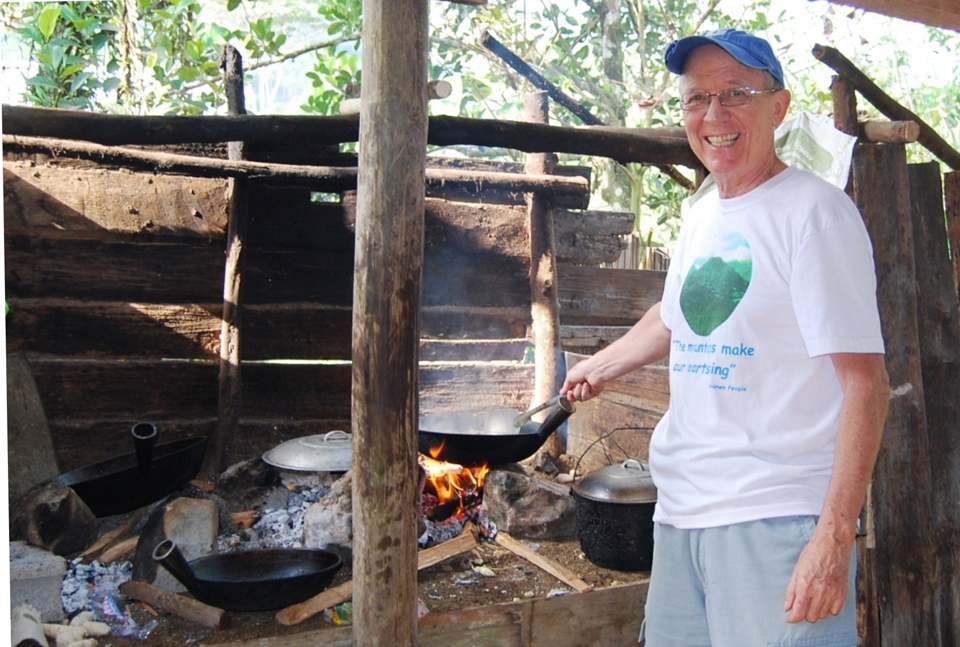
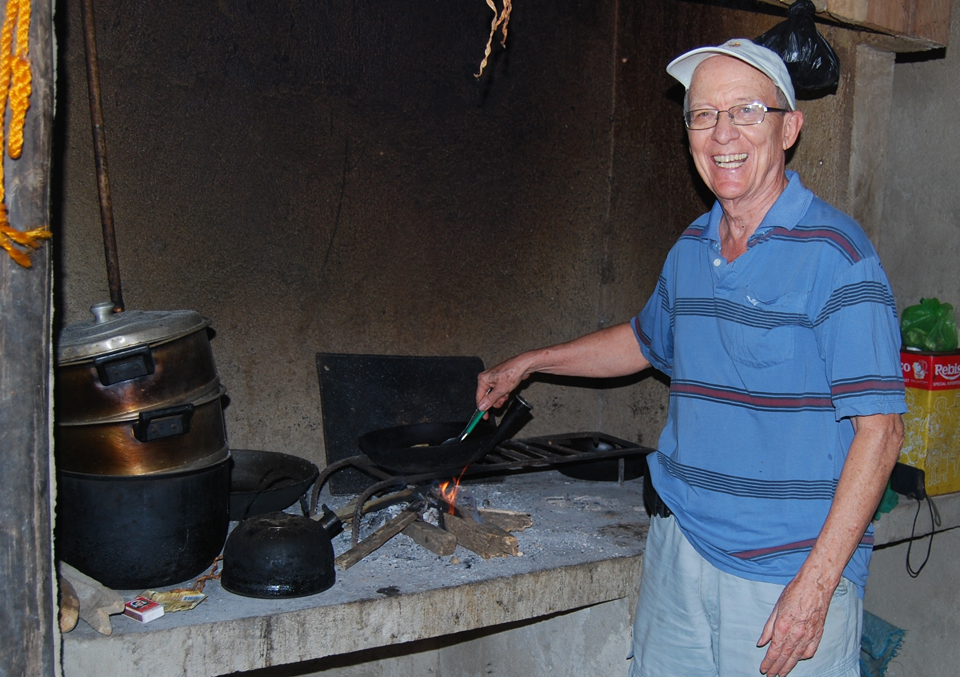
Fr Vincent Busch in outside kitchen; in enclosed kitchen
St Joseph cooking for Mary Christmas card
Having an enclosed kitchen area is a welcome improvement for our home but having food to cook is a necessity. Each year many Subanen families go hungry because they have exhausted their stored grain and root crops. This lean time of the year is called the ‘hunger season’ and it lasts for months. During these months many Subanens develop intestinal illnesses that sometimes require hospital care. Some Subanen families have had to sell their land and farm animals to pay for their medical expenses. Because I have a steady income I can buy rice for my family during the hunger season so we have been able to eat and to keep our land and animals.
As a part of Subanen Crafts I have been able to help my family and help our pre-schools educate our little ones. My craft work also helps me share our culture and celebrate our deep bond with God’s creation. Recently, I designed an adjustable bracelet containing beads that represent the Earth and the other planets. When I look at the tiny blue Earth-bead I think of the Earth as the sacred home of my family and of all people.
The author is a first cousin of Mercy B. Gawason who has had articles in MISYONonline.com here and here. The website of Subanen Crafts is here.
A Christmas Gift to Japan
A Christmas Gift to Japan
By Fr Philip Ilio Bonifacio
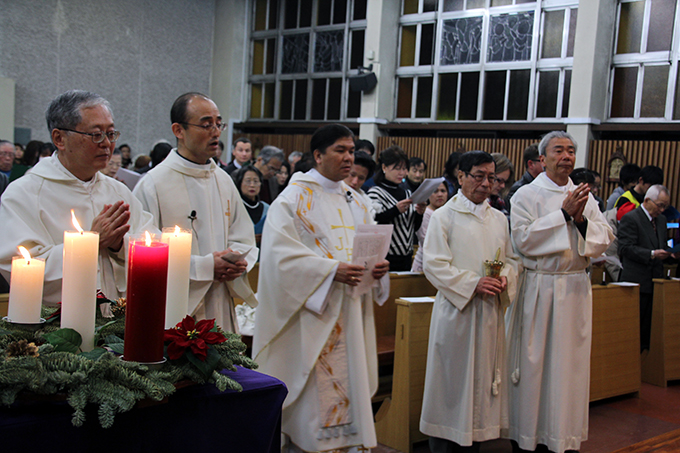
Christmas International Mass 2013, Matsudo Parish, Fr Philip in center
As December starts, people put their Christmas trees up, illumine their houses with Christmas lights and other decorations to create the ambiance of the Christmas season. In the Philippines, people gather in small groups for the evening caroling or daigon, going from house to house using improvised musical instruments. People are excited by the Misa de Gallo. We delight with fireworks greeting the night as we do the count down. It is the favorite time of the year for children as they await their gifts from ninongs and ninangs. Our Christmas comes alive with all the sharing and giving.
I used to think that the spirit of Christmas was the same in every part of the world.

Christmas Children’s Mass 2013
For more than two decades, since I was assigned here after my ordination in 1995, I have spent most of my Christmases in Japan. Catholics – fewer than one in two hundred of the population of more than 127 million and about one fifth of all Christians - attend Christmas Eve Mass, sing some carols and share tea. After that, they go home. The atmosphere is nice with Christmas lights but firecrackers are not allowed, and there’s no house-to-house Daigon.

Tea Party after Christmas Eve Mass
My first Christmas here was a bit lonely. After the evening Mass, I was left alone in the parish since my companion parish priest had left for Ireland. It felt so sad since I had no family to spend the season with. So I called my family in the Philippines to greet them. Then I phoned the Filipino parishioners as they were either alone or with their spouses, also sad for being away from home. We met and agreed to go to a restaurant. Since then we’ve been doing this every year after the ‘Midnight Mass’. We gather as many Filipinos as would like to join us for our Japanese Noche Buena.
Sometimes we go to one house for coffee. It’s a joy also to share Filipino dishes cooked by Filipino parishioners. That’s how we celebrate Christmas. We become one family as we commemorate the birth of Jesus Christ.
In 2012 I became parish priest of St Michael the Archangel Parish, Matsudo, Archdiocese of Tokyo.
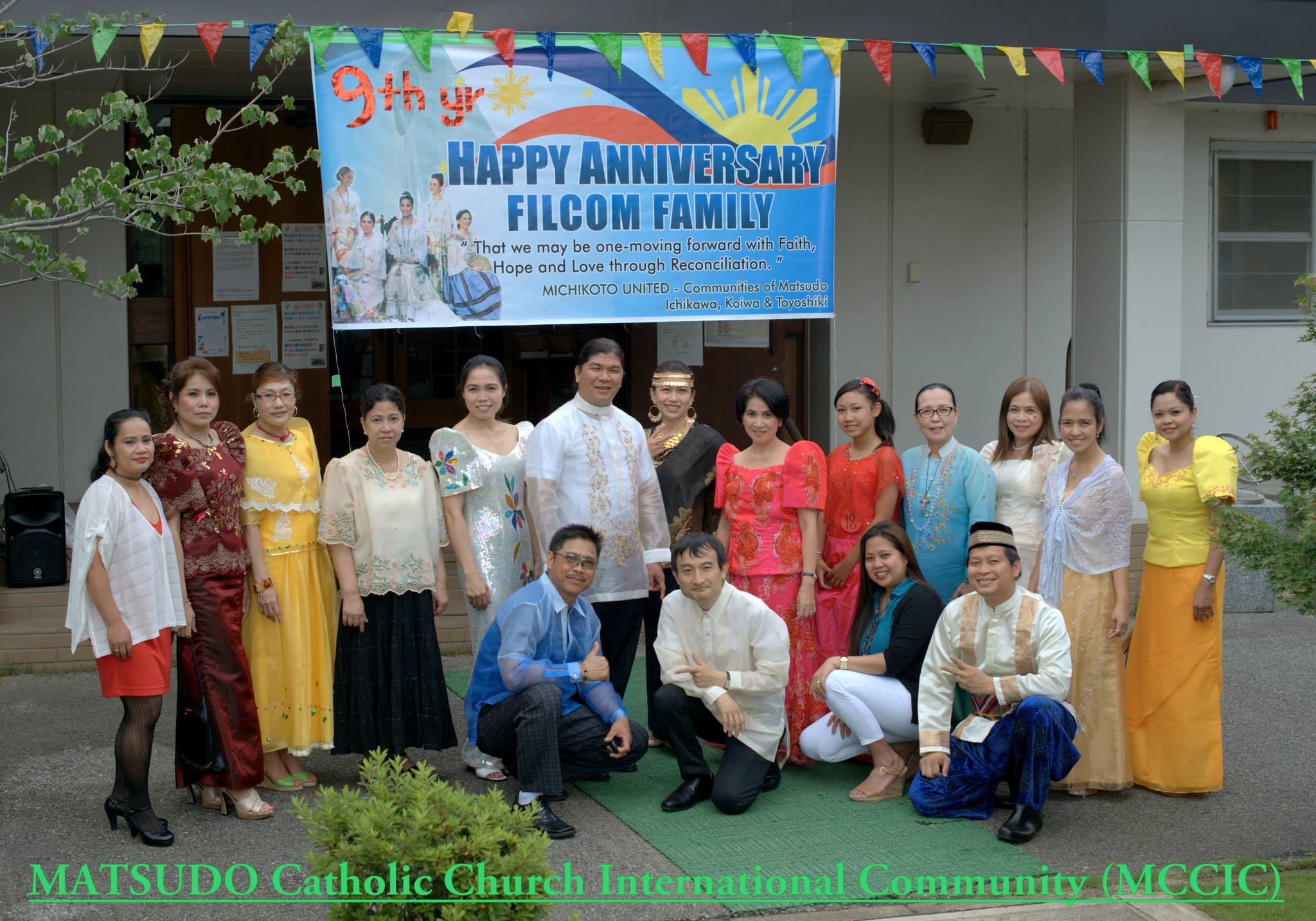
Filipino Community, Matsudo Parish
The Filipino Community is in charge of decorating the hall for the Christmas season. One day I asked myself, ‘How can I make Christmas memorable for the children here in Matsudo?’ I knew I had to initiate something. So two years ago, I incorporated caroling and gift-giving into the Midnight Mass. It was the first of a kind in Japan. Gift-giving in this context might be ordinary for us Filipinos but is something extraordinary for the Japanese.
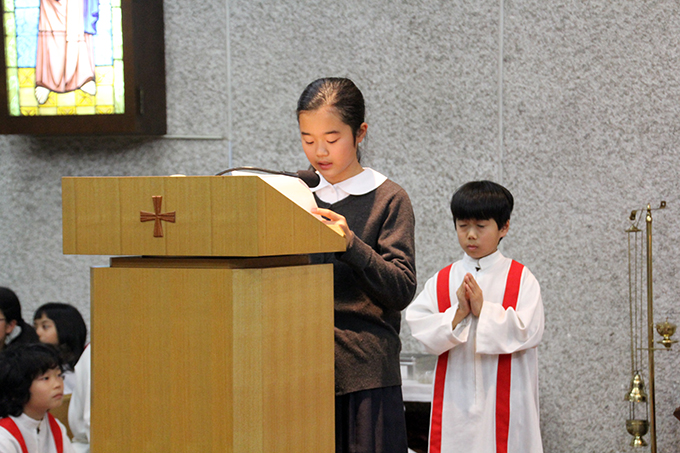
Christmas Children’s Mass 2013
I invited some parishioners to help prepare the gifts for the offertory at Tagalog and Japanese Masses. We came up with between 100 and 200 gifts for children. And at the Christmas Mass, before the final blessing, we invited all the children to come up to receive their gifts. Shy as they might seem, you could see big smiles on their faces.
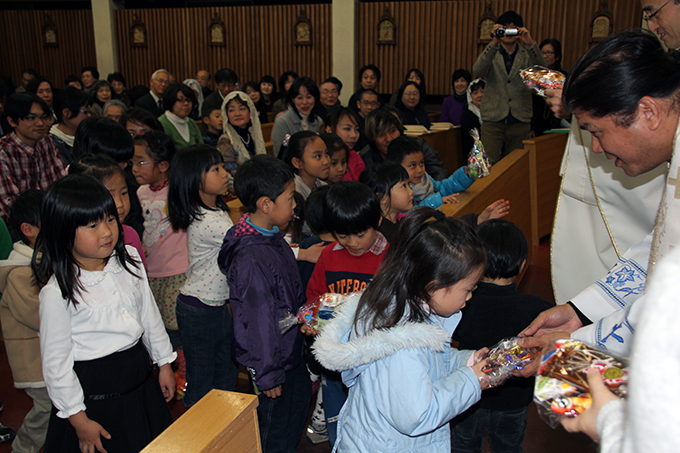
Children receiving their gifts 2015
We also have a kindergarten near the church where I have been teaching English since 2013. I was later invited to become its principal but declined as I had other obligations. My decision was affirmed by the bishop. Before, there had been no connection between the kindergarten and the church. I think it was the previous Japanese priest who drew the line to avoid conflict – let Christian service be for Christians, Japanese for the Japanese only. Christianity is seen as foreign by most Japanese and Filipinos are regarded as foreigners.
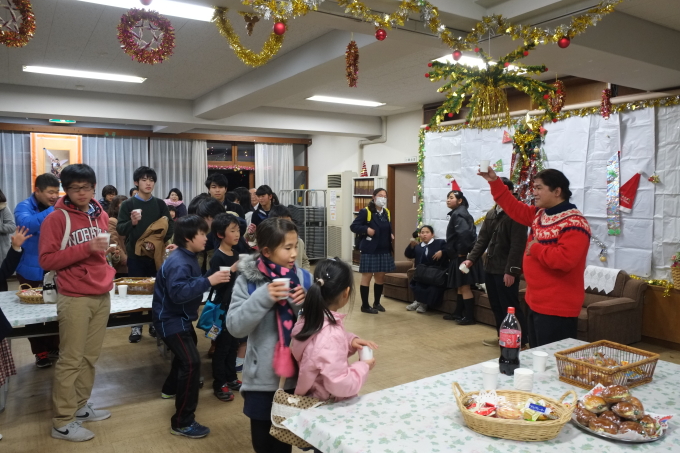
Tea Party with the children 2015
But if you say to Japanese people, ‘our parish is also Japanese’, they are surprised to know that there are Japanese parishioners actively participating in the Church. They often react with, ‘I thought it is only for foreigners’. Some Japanese are a bit shy about their identity, so it’s good to motivate them. We are not exclusive.
Carol singing before Christmas Eve Mass
Since the principal of the kindergarten is a Catholic, I talked to her and invited the Japanese children in Yōchien (kindergarten) to join the parish Mass on Christmas Eve or on Christmas Day so that we might also give them gifts. She responded positively.
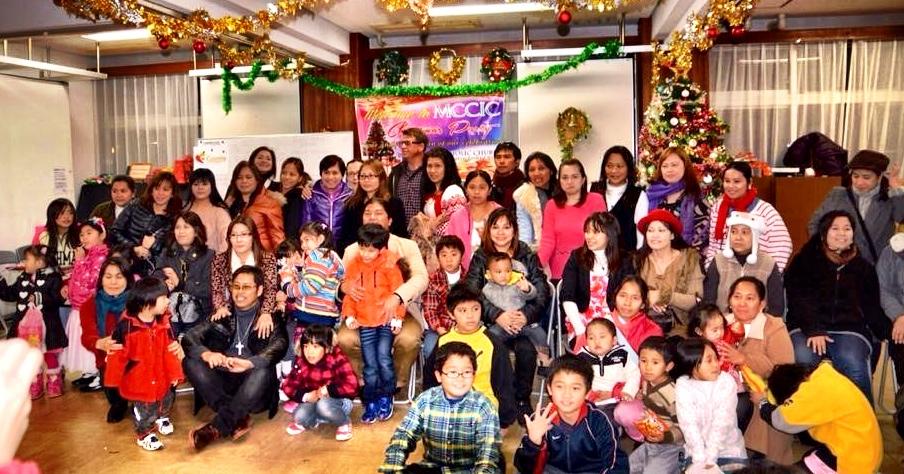
In the parish hall, Christmas 2013
The day came with Japanese children bringing their parents and grandparents. For the first time, they experienced the church community on Christmas Day and a parish giving gifts to children. Since we are in the context of the Church, we say that Father (Priest) was distributing the gifts, not Santa Claus. The kids wore big smiles as they received their gifts. They were delighted and we were more than happy to see them rejoice on Christmas Day, a memorable occasion for them and one they now look forward to each year.
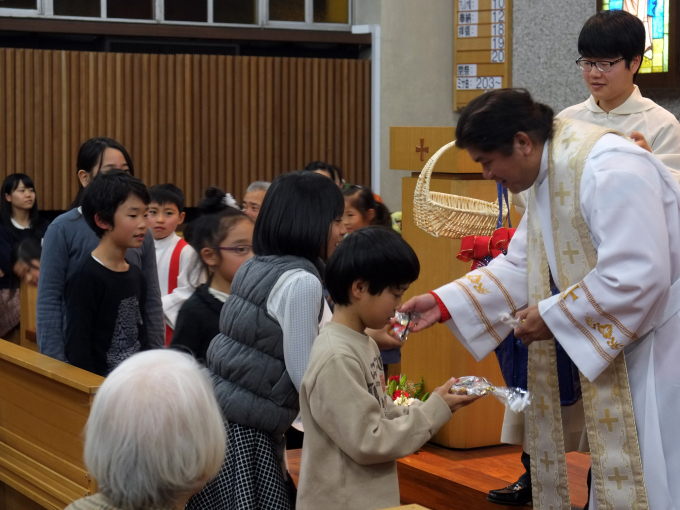
Children receiving their gifts 2015
Some Japanese members of the Parish Pastoral Council initially questioned this, thinking that it would entail expenses. But ‘This is Christmas and we don't usually do this’ prevailed and we all ended up happy. The beauty is that with Japanese children bringing their grandparents, the elders now want to come back. And the Catholic parents are also encouraging grandparents to tag along with their grandchildren. So we came upwith an additional preparation for Christmas, a Communal Rite of Reconciliation for the Japanese on the first or second Saturday of December.
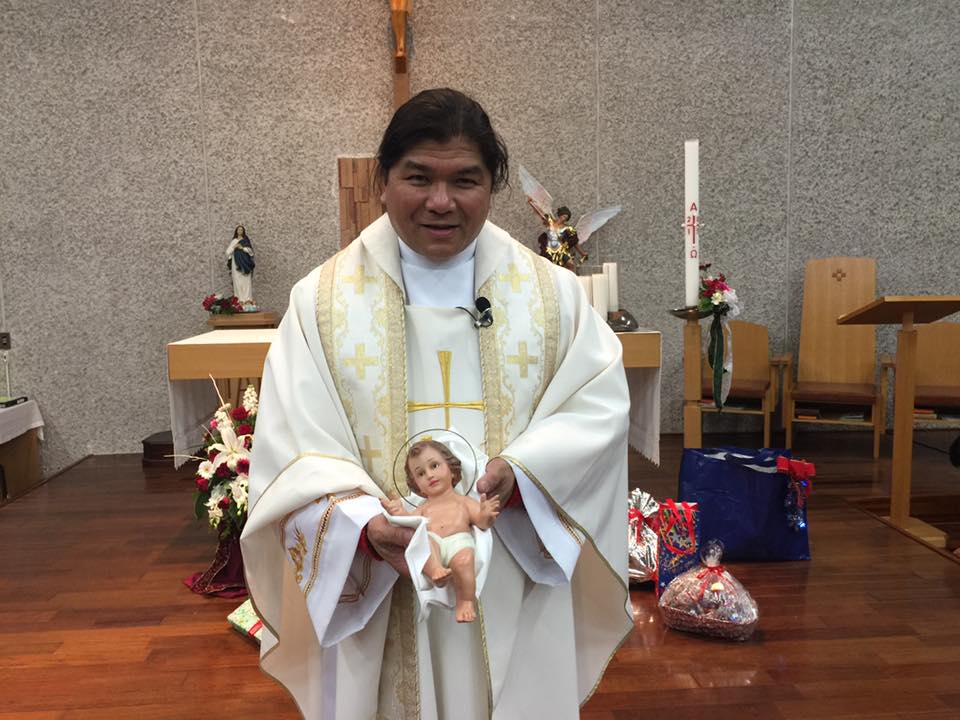
Fr Philip with Baby Jesus, Christmas 2015
I am happy with this kind of Christmas spent with the children and their families, happy because parents are very supportive in bringing their children – and there are many of them - to church. It's nice to see them re-introduced to the Church. Others who learned about this activity start to inquire about the different services offered by the parish.
Mother Church is inviting us ‘to go out and find your sheep’. And this is how we in Matsudo Parish have responded. This is our Christmas gift to Japan.
The Little Angels of Nagasaki with Andre Rieu
‘Silent Night’ in Japanese
COLUMBANS ‘WHO HAVE GONE BEFORE US WITH THE SIGN OF FAITH’ DECEMBER 2015 – OCTOBER 2016
Columban Pilgrimage 2016

On 28 September, a large group of those involved in the mission of the Columbans in the Philippines and elsewhere, and four very special visitors from New Zealand, went on a pilgrimage to two places particularly associated with Columban Fr Francis Vernon Douglas: Pililla, Rizal, with his life, and Paete, Laguna, with his torture and death at the hands of the Japanese in 1943. Like the original Columban priests, Fr Douglas was already a diocesan priest, of the Archdiocese of Wellington, when he joined the Society in 1938. Like many other Columbans he met a violent end, in the service of Jesus Christ and his people. Like Jesus, he was scourged at a pillar and was 33 when he died.
Below are the featured articles written about the Pilgrimage:
Columban Pilgrimage to Pililla and Paete by Fr Rex Rocamora
The stirring within my soul began shortly after praying at the post, more so when I witnessed others praying solemly there as well. ‘Do you feel something within you?’, I had to ask, Verne, one of the New Zealanders, as my emotions were welling up. Had I been foolish in asking her? But she quickly replied, ‘I’m his niece’...
Homily at Memorial Mass of Fr Francis Vernon Douglas, Church of St James the Apostle, Paete, Laguna, Philippines by Fr John Keenan
Let us imagine the scene in this very church: ‘ECCE HOMO’, ‘BEHOLD THE MAN’, put before all the frightened prisoners as to what might happen to them also. Then he was dragged to the baptistery and tied to the font and further tortured...
Prayer for the Promotion of the Cause of Fr Francis Vernon Douglas
Heavenly Father we join together with the people of New Zealand and of the Philippines who are praying for the promotion of the Cause of Fr Francis Vernon Douglas SSC. We are inspired by his example of heroic faith, courage and commitment to the Gospel...
United with Father Vernon, a Pilgrimage to Remember by Mary Joy Rile
The thought of his excruciating pain evoked in us deep sorrow, wishing to console him, yet we also recognized that sense of gratitude and awe for his courage in facing such a death. Holding the pillar as if reaching out to Fr Vernon felt like we were united with him...
What the Pilgrims Say
The experience was surreal. I felt sad yet honored, privileged, and blessed to have walked the floors that Fr Francis Vernon Douglas walked, touched the pillar where he was tied up and tortured, entered through the doors where he welcomed my fellow Filipinos...
Other Related Links:
Cover Story Photo by Fr Rolly Aniscal
Here was a Strong and Brave Man by Fr John Keenan
Pulong ng Editor by Fr Seán Coyle
Shaken and Stirred by Fr Pat O’Shea
Columban Pilgrimage to Pililla and Paete
By Fr Rex Rocamora
The author is a Columban priest from Ipil, Zamboanga Sibugay. He was ordained in 2000 and until this year was based in China. He is now in Our Lady of Remedies Parish, Malate, Manila. His brother, Fr Joseph Joy Rocamora, is a priest in their home Diocese of Ipil.
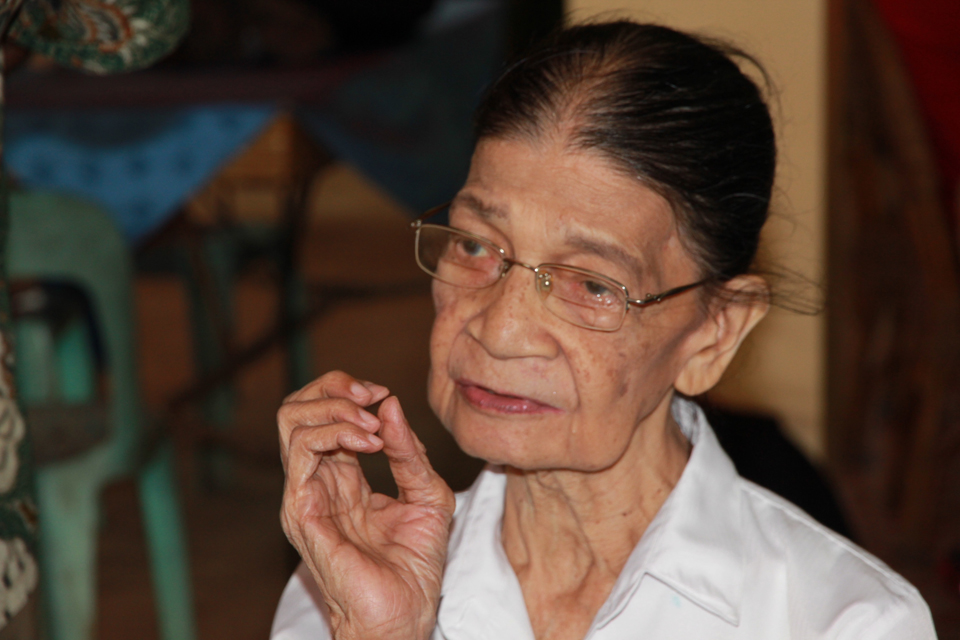
Miss Dominga Bayocot sharing her memories of Fr Douglas
‘No wonder he was always looking towards the altar’, said Miss Dominga Bayocot who had witnessed as an eight-year-old the man tied to one of the pillars in St James the Apostle Church, Paete, Laguna, after realizing that he was a priest. She was speaking in Tagalog but I noticed the interpreter missed this line and didn’t translate it for the pilgrims who were listening intently to the accounts of two witnesses – the other was Mrs Aurelia Cadapan – to events in the church in July 1943. It was an important line, I thought. They spoke to us after a lunch hosted by the parishioners at Lunal Paradiso Resort in an off-road garden setting.
Manila traffic bogged down the bigger of two buses carrying pilgrims to Pililla, Rizal, where Columban Fr Francis Vernon Douglas from New Zealand had been parish priest in the early years of World War II, and to Paete, Laguna, where he had been tortured and killed by Japanese soldiers. We pilgrims included Columban priests, lay missionaries and workers from many countries and relatives of Fr Douglas from New Zealand. Our bus almost skipped Pililla because we were running very late and we only had one day, 28 September 2016, to do this pilgrimage, to see and hear about Fr Douglas, known to his family as ‘Vernon’.
On the way, conversing with fellow pilgrims, praying and singing as well, and seeing rural of Rizal and Laguna from a front seat was very pleasant. Finally after many hours on the road, including a visit to St Mary Magdalene Church in Pililla, and our lunch, we slowly moved down the narrow street leading to Paete church and parked near the town hall. A local person told me that the name ‘Paete’ comes from the Tagalog word ‘pait’ or ‘paet’, ‘chisel’. The town has been famous for centuries for its woodcarving.
The old adobe church of Saint James the Apostle stands at the foot of a mountain. I entered the church, which was quiet and calm, and approached and, as other pilgrims were doing, prayerfully touched the post to which one of Fr Vernon’s hands had been tied. He held his rosary in the other, or so I imagined.
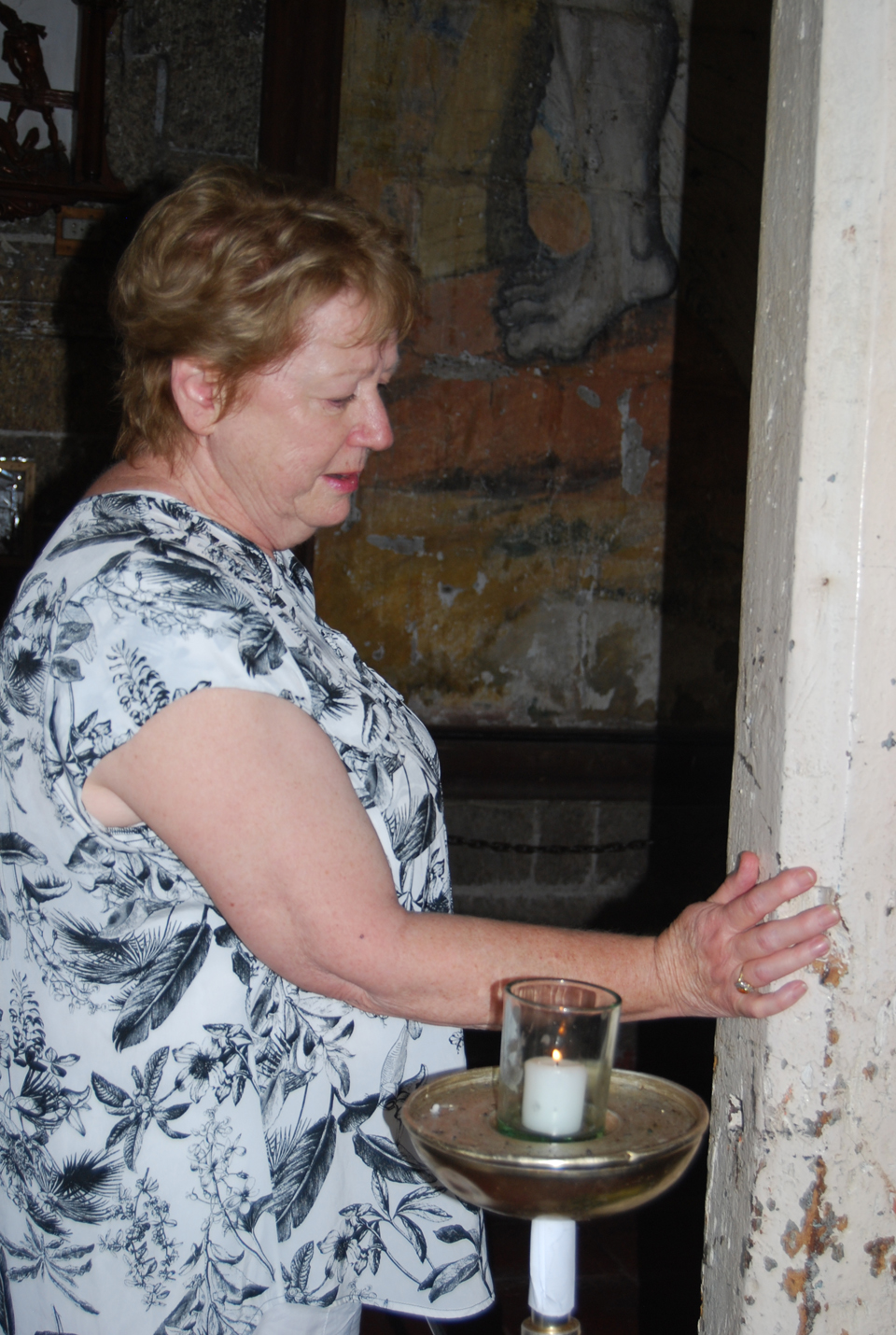
Mrs Verne Turner at the pillar where her uncle was scourged
The post is one of two supporting the choir loft and is near the baptistery, which was the ‘torture chamber’ of Fr Vernon’s three-day ordeal. Then the stirring within my soul began shortly after praying at the post, more so when I witnessed others praying solemnly there as well. ‘Do you feel something within you?’, I had to ask, Verne, one of the New Zealanders, as my emotions were welling up. Had I been foolish in asking her? But she quickly replied, ‘I’m his niece’. Verne was born in April 1945 on the day the Douglas family received news of the death of Fr Vernon, hence her name. I was thinking that she had feelings that could not be expressed in words. We talked and went to the baptistery where we prayed in silence with a few others. We heard of the locals’ plan to install stained glasses in there; the image of St James the Apostle on one side and of Fr Vernon on the other.
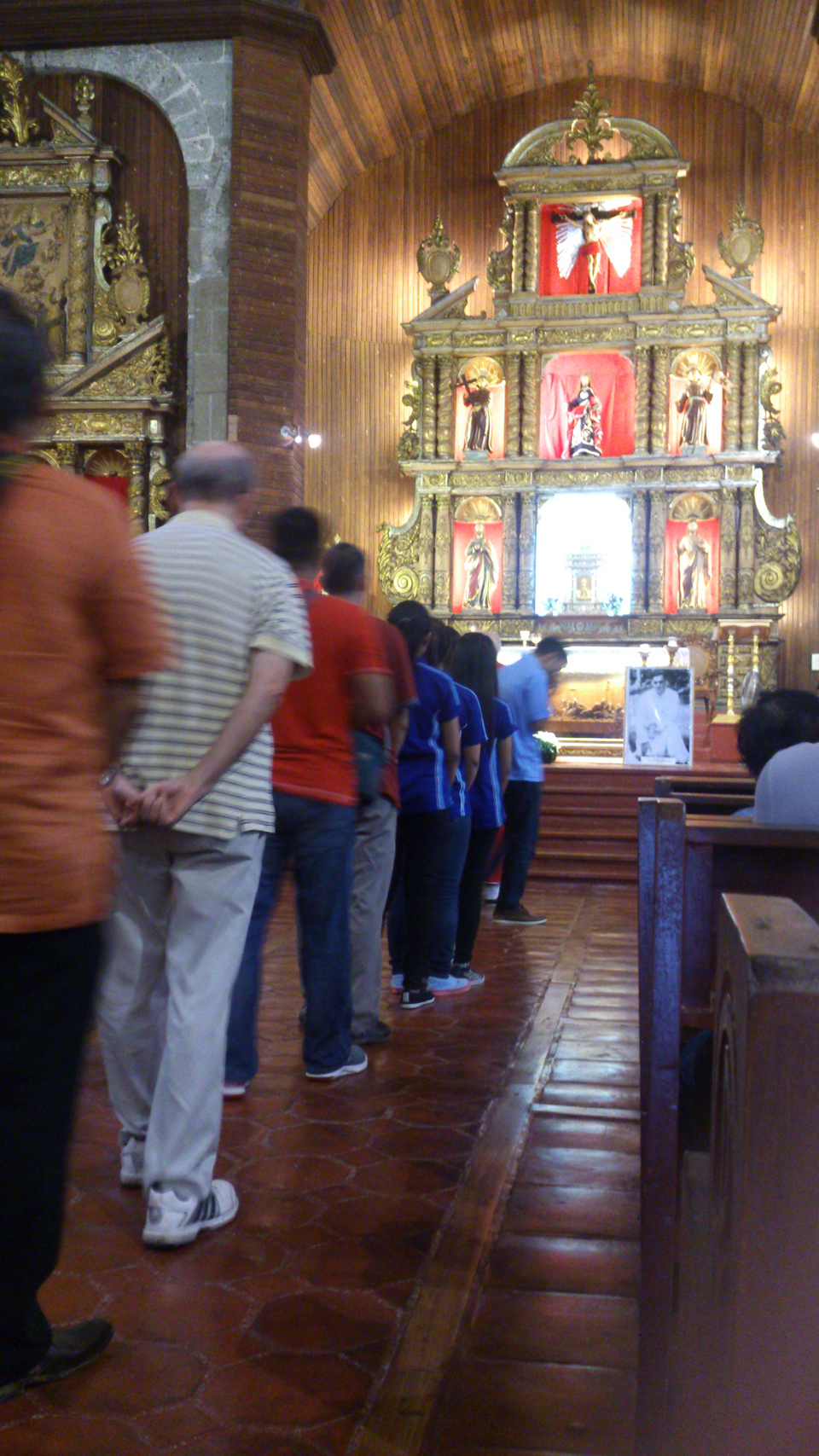
Receiving Holy Communion during Mass
While I was praying at the post, a spontaneous conversation with God was quietly going on within me. It happened again during the Mass at which Columban Fr John Keenan, whose article Here was a Strong and Brave Man, first published in 2001, has stimulated much interest in Fr Vernon, was the main celebrant and homilist. Before the final blessing, Fr Dan O’Malley, the Columban Regional Director, an Irishman, spoke briefly, followed by inspiring words of thanks by Verne.
After Mass I walked outside the church and saw a vendor and bought a mortar and pestle chiselled out of molave wood. It symbolizes for me the ‘grinding’ that our fellow Columban, Fr Vernon, was subjected to. Terrible, it must have been. But I wanted to remember it as a graced moment between him and God, a shared moment with the crucified Lord. Martyrdom may not be for many, but everyone is called to holiness. God is alluring and inviting. The memory of Fr Vernon’s death has stirred a willingness within me to listen to God’s call to holiness, to total self-giving. On this pilgrimage to Paete I felt God’s gentle call to move on the path towards Him, the most Holy One.

Some of the pilgrims outside Paete Church
Homily at Memorial Mass of Fr Francis Vernon Douglas
Church of St James the Apostle, Paete, Laguna, Philippines
By Fr John Keenan
On 28 September this year a group of Columban priests, Columban Lay Missionaries and co-workers, along with four relatives of Columban Fr Francis Vernon Douglas from New Zealand set off on a one-day pilgrimage to the two places associated with his death in 1943, Pililla, Rizal, and Paete, Laguna. Here is the homily given by Fr John Keenan, a Columban who came to the Philippines from Ireland in 1966, at the Mass in the church of St James the Apostle, Paete. His article, Here Was a Strong and Brave Man, first published in MISYON in January-February 2001, has renewed awareness of the martyrdom of this heroic priest from New Zealand.
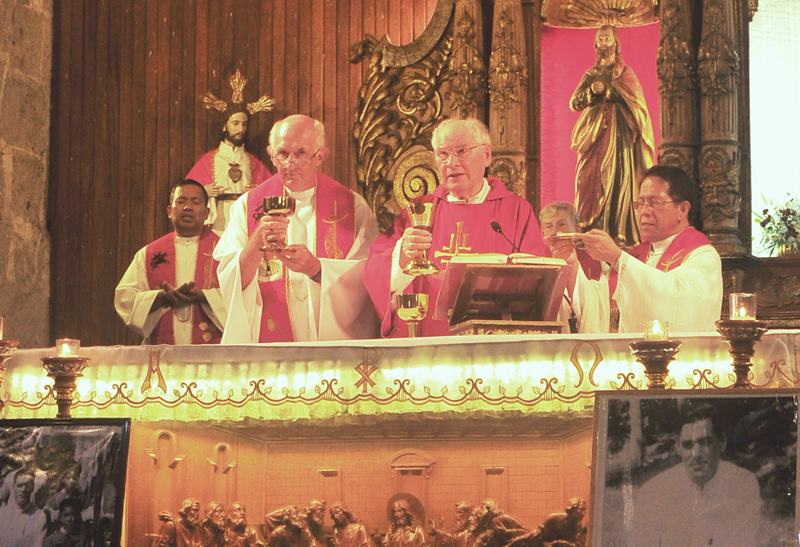
Fr John Keenan and concelebrants
Magandang hapon po sa inyong lahat at maraming salamat para sa inyong pagdalo sa Misang ito para kay Padre Francis Vernon Douglas. Having traced the last journey of Fr Vernon Douglas from Pililla Catholic church where he was abducted to this church of St James the Apostle, we have reached the goal of our pilgrimage. It was here that Fr Vernon spent the last three tortuous days of his life. We remember him affectionately and pray for his eternal repose.
Good afternoon everyone and many thanks for joining us at this Mass in memory of Fr Francis Vernon Douglas. A special welcome to his niece Verne and her husband Cliff Turner, also to his nephew Vernon Douglas and his son Brendan. It is wonderful that you are here all the way from New Zealand. Very many thanks to your parents and grandparents for the big sacrifice which they made at the time of the death of Fr Vernon.
Our feast today is that of St Lorenzo Ruiz and companions who were martyred in Japan some 400 years ago. Like them, Fr Vernon was made to endure terrible tortures for his faith in Jesus Christ. It is providential and a great co-incidence that our theme for today is that of martyrs.
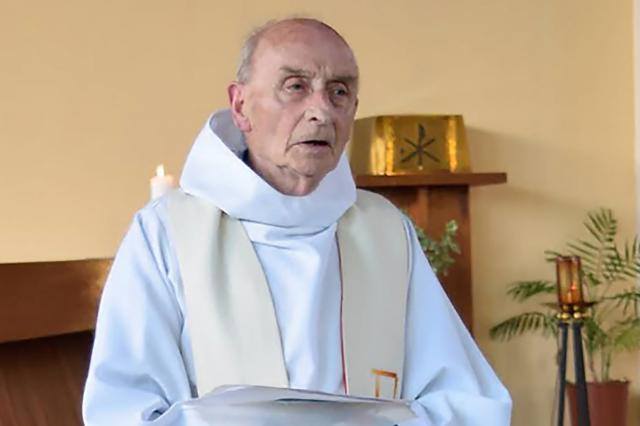
Fr Jacques Hamel
(30 November 1930 – 26 July 2016) [FB]
In his homily to the relatives of Fr Jacques Hamel, 85, the elderly priest who was murdered by members of the Islamic State (near Rouen, France), Pope Francis said that there are more martyrs for the faith in modern times than in the early days of Christianity. In our times many priests, sisters and lay people have been killed for their Christian witness.
Pope Francis speaks about the martyrs of our times
Some 400 years ago Filipino St Lorenzo Ruiz and his companions were martyred in Japan, also St Pedro Calungsod, a Filipino catechist was killed in the Marianas Islands.
In February 1945 five Columbans were martyred in Malate parish and more recently Fr Tom Flynn in Labrador, Pangasinan in 1950, Fr Martin Dempsey shot dead in Mindanao in 1970 and Fr Rufus Halley mowed down in 2001 also in Mindanao.
Before them Fr Francis Vernon Douglas at the age of 33, after being severely tortured in this Church of St James, Paete, was killed on 27 July 1943 – 73 years ago. Our presence here today means that his supreme sacrifice is not forgotten, nor should it ever be.
When news of the martyrdom of St Lorenzo Ruiz (and companions) reached Manila all the church bells in the diocese were rung in thanksgiving to God for their fidelity to their faith in Jesus Christ. So here also we joyfully give thanks for Fr Vernon’s splendid and heroic witnessing to his Catholic and Christian faith.
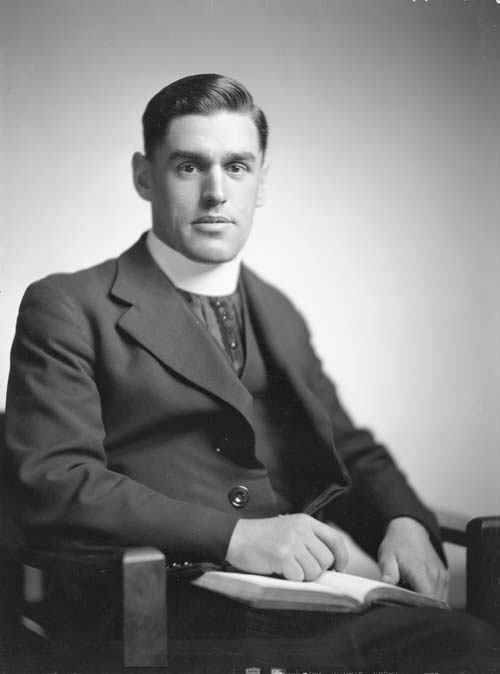
Fr Francis Vernon Douglas
Fr Francis Vernon Douglas was born on Sunday 22 May 1910 to Catherine Gaffney from Ireland and George Douglas from Australia, in Johnsonville, Wellington, New Zealand, the fifth of eight children. After graduating as valedictorian from Mosgiel at the age of 14 to help his family financially he worked in the local post office and later as postmaster for three years. Responding to the call to priesthood, he entered Holy Cross Seminary in Mosgiel destined to serve in the Archdiocese of Wellington. After eight fulfilling years he was ordained a priest on 29 October 1934. For over three years he worked zealously in various parishes in his home diocese of Wellington.
Sensing a call to be a missionary he applied to Fr Luke Mullany, superior of the Columbans in Australia and New Zealand, who accepted him as a member of the Missionary Society of St Columban in 1937. After a year’s study and preparation he was sent to the Philippines and arrived in Manila in July 1938. After a brief stay in Malate he was assigned to Binangonan and Morong (both in Rizal) to learn the local language, Tagalog.
At the early age of 28 he was assigned as parish priest to Pililla, Rizal. This parish was very much run-down having been 40 years without a resident priest. Because of typhoons and floods the church and convento (rectory/presbytery) were in bad shape. Being young and energetic he set to work along with the local people and gradually renovated the church and convento where he lived. Through liturgies, catechesis, meetings they gradually built a loving Christian Community. As a zealous priest he often visited outlying villages to attend to the sick and respond to the various needs of the people in the hills around Pililla.
At that time many of the people in the hills resisted the Japanese military police known as the dreaded Kempeitai. In the eyes of the Japanese he was ‘an enemy alien’ and was suspected of collaborating and spying for the guerrillas.
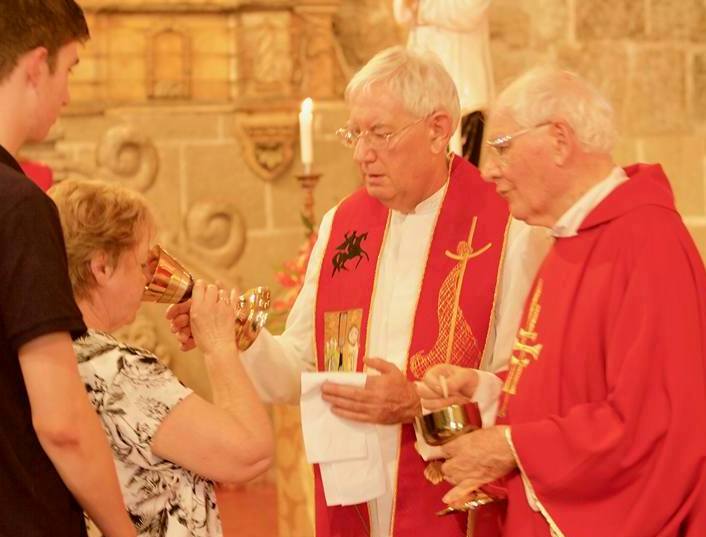
Mrs Verne Turner, Fr Dan O’Malley and Fr John Keenan
Mrs Turner, whose mother was a sister of Fr Vernon, was born on the day in 1945 when the Douglas family learned of his death in 1943, hence her name.
On the afternoon of Saturday 24 July 1943 he was interrogated by the Japanese in his convent. He was heard to say in answer to a question, ‘I cannot answer you and you have no right to ask me that question’. Many believe that he was referring to the seal of confession which he refused to break regarding what he knew about the guerrillas. He was abducted from the convento that day and brought by truck to this Church here in Paete. This was used as a concentration camp with some 1,700 prisoners, men and youths held in atrocious conditions.
The sacristy was used as a torture chamber where many prisoners died. Here he was taken and severely tortured. He was given the dreaded water–cure but still refused to give any information. Like Jesus before Pilate he uttered not a word. Later he was tied to the altar rails and further beaten. Let us imagine the scene in this very church: ‘ECCE HOMO’, ‘BEHOLD THE MAN’, put before all the frightened prisoners as to what might happen to them also. Then he was dragged to the baptistery and tied to the font and further tortured.
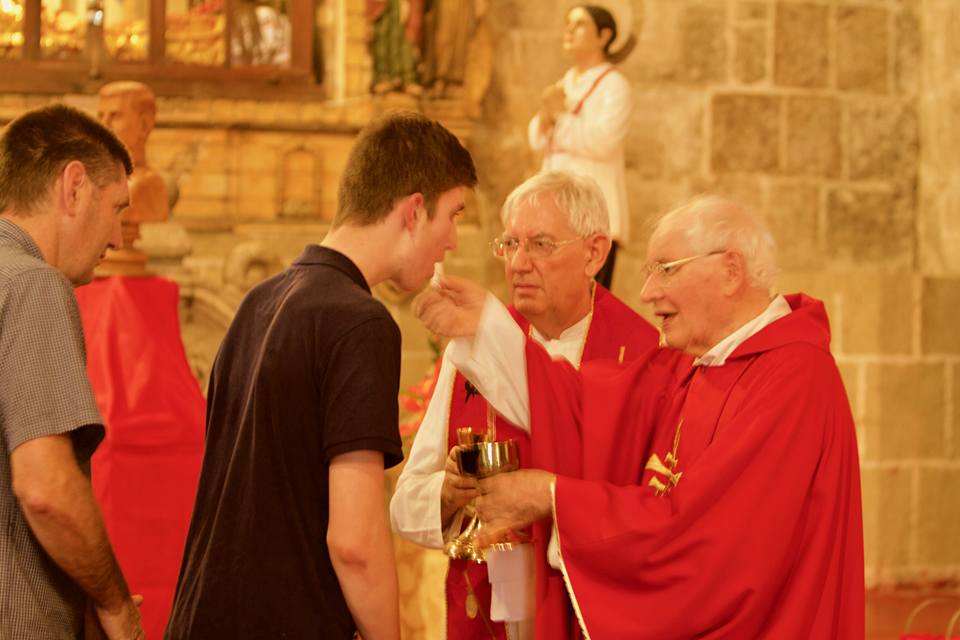
Vernon and Brendan Douglas with Frs O’Malley and Keenan
Vernon is a nephew of Fr Douglas, a cousin of Verne and the father of Brendan
Later he was manacled to the post beside it under the choir loft there. With one hand tied to the post above his head he was left to stand for two days and two nights. He was allowed neither food nor drinks even though the people had brought some for him. His eyes, swollen and bloody were fixed on the tabernacle while he fingered his rosary beads, which he was allowed to keep. Like Jesus before his tormentors he remained silent.
Realising that the end was near he asked to see the local parish priest, Fr Nicomedes Rosal, to whom he made his last confession.
Later, as night was falling, he was bundled into the back of a truck and driven off into the night in the direction of Sta Cruz (capital of Rizal Province). He was never seen again. The speculation is that he died from the effects of the beatings and torture he endured, or that he was killed and buried in an unmarked grave in a rice-field or in the vicinity of Sta Cruz town.
Pope Francis called the French priest who was murdered a couple of months ago in his parish in northern France a martyr. He said that we can pray for him and pray to him for our various needs and petitions. Fr Hamel suffered only for a couple of minutes. Fr Vernon suffered excruciatingly for three days and three nights. We also can pray for him and to him for our sick and for other needs.
The prisoners did not fail to notice that torture on them ceased after Fr Vernon’s arrival. All the anger seemed to be concentrated on him. They thought of him as their savior, like Jesus.
Some 2,700 years ago the prophet Isaiah said: ‘Yet it was our pain that he bore, our sufferings he endured . . . by his wounds we were healed (Isaiah 53:4-5). Fr Vernon’s faith, courage, commitment and fidelity to the end are an inspiration and example for all of us Columban missionaries and everybody else to follow.
Within a short time after Vernon’s death the zoning of the town ceased and all the prisoners were released and allowed to return to their homes. Maybe someday, with God’s help, Fr Francis Vernon Douglas will be listed with the church’s martyrs. He may become the first (canonized) Columban saint and the first saint and martyr from New Zealand.
Maraming salamat kay Fr Noel Canopio, Parish Priest, sa Sangguniang Pastoral ng parokya ni St. James Apostle at sa inyong lahat. (Many thanks, to Fr Noel Canopio, Parish Priest, and to the Parish Council, and to all).
Church of St James the Apostle, Paete
Prayer For The Promotion of The Cause of Fr Francis Vernon Douglas

Fr Francis Vernon Douglas
Heavenly Father we join together with the people of New Zealand and of the Philippines
who are praying for the promotion of the Cause of Fr Francis Vernon Douglas SSC.
We are inspired by his example of heroic faith, courage and commitment to the Gospel.
We pray in confidence that by his example we will be inspired to do likewise and
live the call of Jesus as peacemakers, promote nonviolence and love of our enemies.
May the Holy Spirit move the hearts and minds of the Church and proclaim
Fr Francis Vernon Douglas as witness of the faith. Amen.
Mother Mary... Pray for us.
St James the Apostle... Pray for us.
St Mary Magdalene... Pray for us.
United with Father Vernon, a Pilgrimage to Remember
By Mary Joy Rile
The author is Editorial Assistant of MISYONonline.com and Columban Mission.
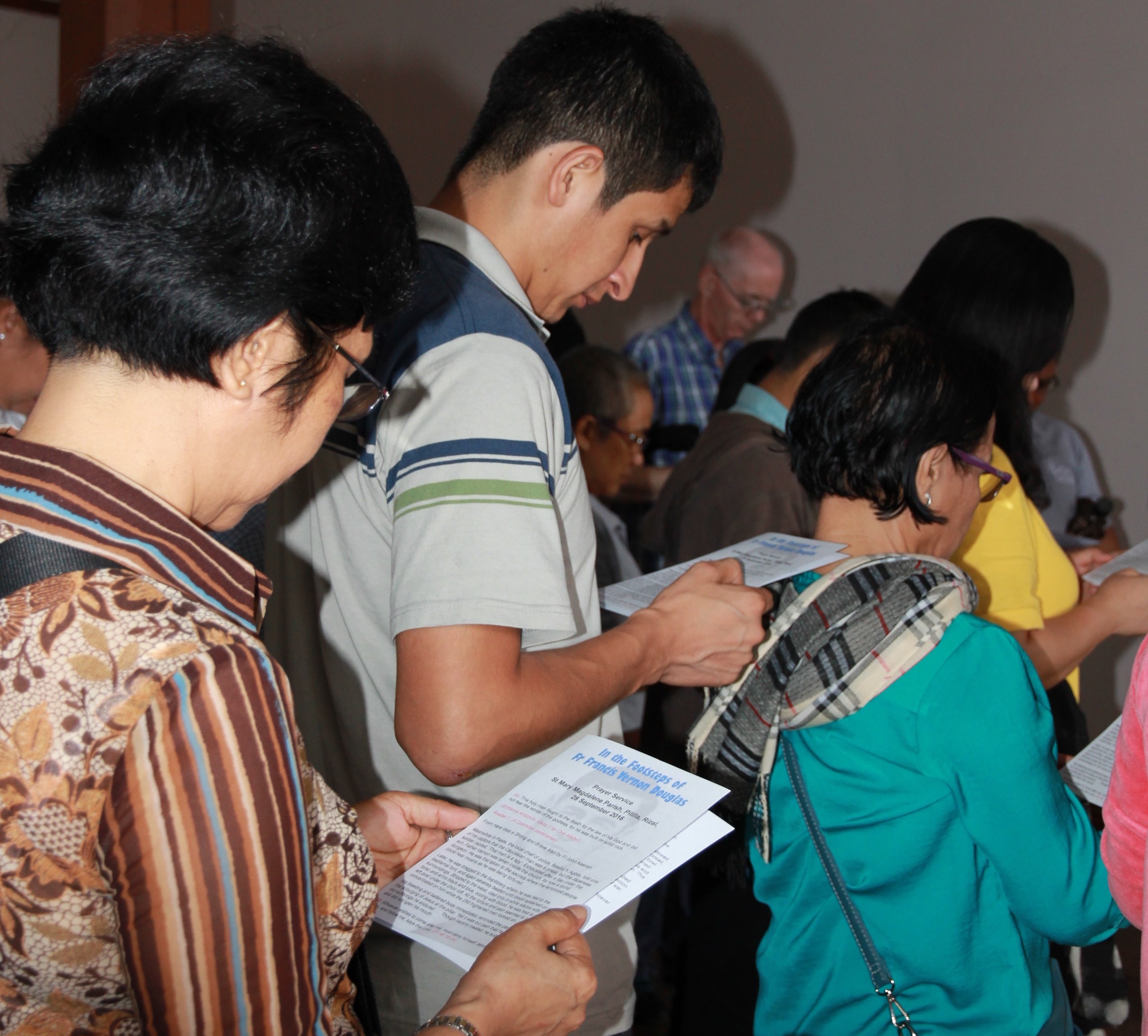
Prayer Service at St Mary Magdalene Parish Church, Pililla, Rizal
Columban missionaries and co-workers, with members of the Douglas family, gathered at 5:30am in Singalong St, Manila, on 28 September 2016, the feast day of the first Filipino martyr, St Lorenzo Ruiz. We were commemorating the life and death of Columban Father Francis Vernon Douglas, a New Zealander martyred in the Philippines in 1943. Riding on two buses, 68 of us started our pilgrimage with rain to grace our day, traffic to greet us in between and delays to test our endurance. But these challenges were a small sacrifice compared to the suffering that Fr Vernon bore.
We had Morning Prayer and rosary along the way. The prayer of Fr Dan O’Malley, Regional Director, was truly humbling, ‘We ask for forgiveness for having lost your story over the years. But we rejoice that we have re-discovered this. And in this re-discovery, deepen our own faith, our own commitment in our troubled times in this nation.’
When we reached the church of St Mary Magdalene, Pililla, Rizal, we visited its different parts before having a prayer service in the sala, which Fr Vernon had used as his room.
The readings and silent moments for reflection helped us internalize what he had gone through.
We continued the journey going to Paete, Laguna. We had a stopover for lunch at Lunal Paradiso Resort hosted by the parishioners. Afterwards two eye-witnesses, Mrs Aurelia Cadapan and Miss Dominga Bayocot, shared their personal encounters with Fr Vernon. Their sharing was moving and when we reached the church of St James the Greater we were drawn to venerate especially the wooden pillar to which the Columban priest had been tied. The atmosphere brought us back to the time of his suffering. The thought of his excruciating pain evoked in us deep sorrow, wishing to console him, yet we also recognized that sense of gratitude and awe for his courage in facing such a death. Holding the pillar as if reaching out to Fr Vernon felt like we were united with him. Such a grace!
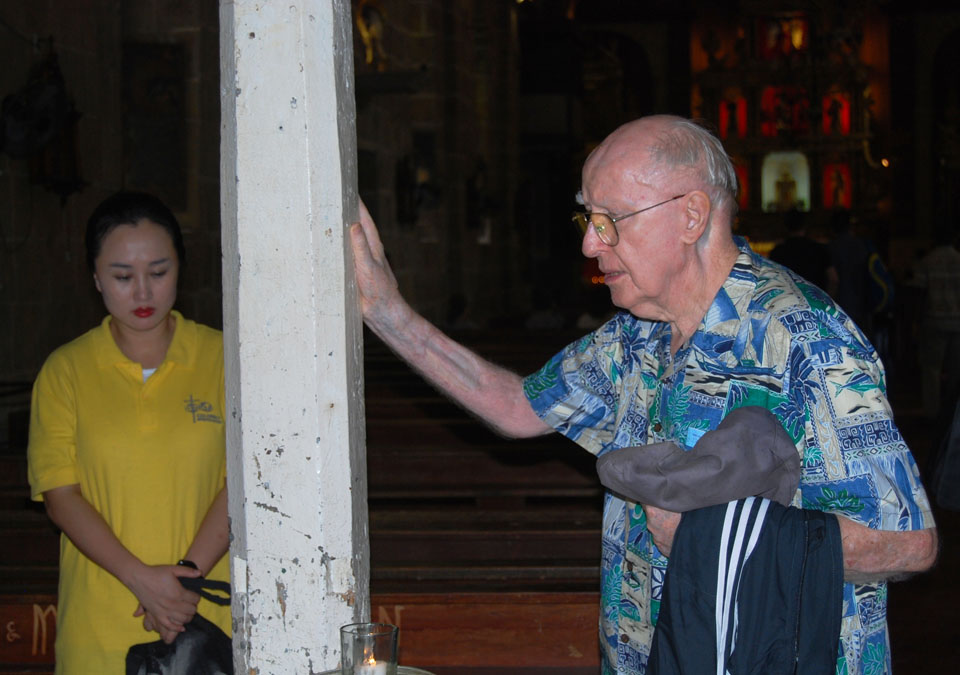
Fr Kevin McHugh venerating the pillar that Fr Vernon was tied to
We celebrated the Eucharist along with some parishioners and students of Liceo de Paete. Msgr Jerry V. Bitoon, Vicar General of the Diocese of San Pablo, was one of the concelebrants. He said, ‘You see, he was a priest in Pililla, Rizal, and he was just brought here. Was it God's design? For what reason? We do not know. But we are happy that we've been part of that.’ Columban Fr John Keenan gave an inspiring homily on the life and death of Fr Vernon.
An ancient Spanish tradition is that the Blessed Virgn Mary appeared to St James the Greater as he was praying by the banks of the River Ebro near Zaragosa in Spain. She was resting above a pillar. This is the origin of the great devotion in the Hispanic world to Nuestra Señora del Pilar, Our Lady of the Pillar. Fr Vernon was a parish priest of St Mary Magdalene but was taken to another church, St James the Greater, where he was tied to a pillar and tortured.
To be snatched from your own people and made to suffer in front of others who didn’t know you at all – what suffering that must have been for Fr Vernon, having no friend to comfort him! Though silent, he was seen moving his lips in prayer, holding his rosary. Was he not in the company of Jesus and Mary? He found that friendship with God, his source of strength that made him conquer all the pain and suffering. He was probably in that state of union with God where he could only submit himself without resistance, denying himself for the sake of others.
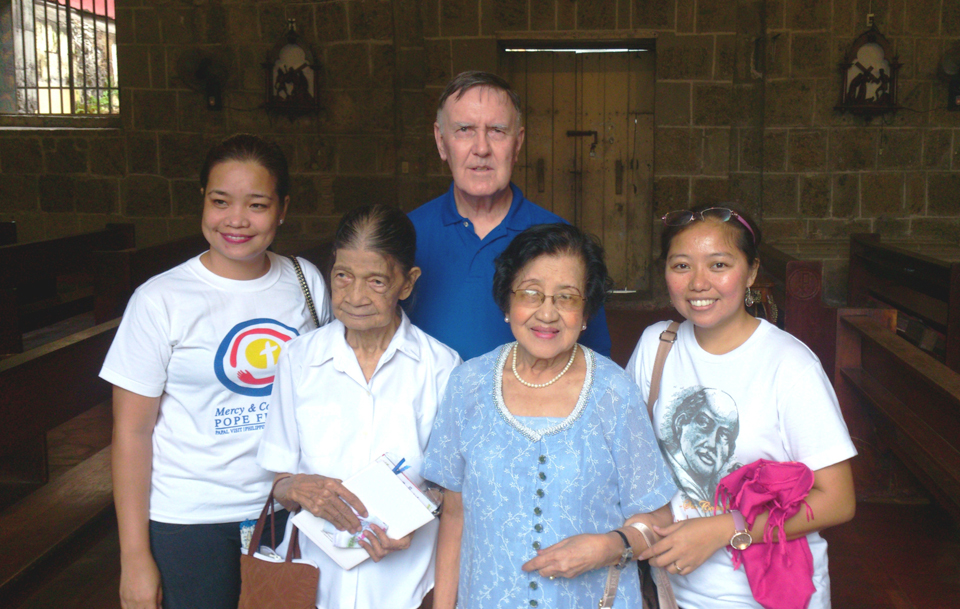
Misyon editor and staff with the two eye-witnesses, Miss Dominga Bayocot and Mrs Aurelia Cadapan
Miss Dominga Bayocot recounted the sharing of her uncle who was next in line to be tortured in the baptistery of the church. The Japanese soldiers vented all their cruelty on Fr Vernon so that after him none of the other men were tortured, but freed. They were saved by that one white man whom they had only encountered during those three days. He was then taken away to some unknown place and never seen again. But Mrs Aurelia Cadapan, who told us that the remains of St James were discovered centuries after his death, continues to pray and hope that one day we will also find the remains of Fr Vernon Douglas. If he will be canonized some day, he will then be the first martyr of New Zealand and the first canonized saint to die in the Philippines, as St James the Greater has been traditionally considered to be the first martyred apostle.
It is normally a family’s desire to give one of their members a decent burial. But for a pilgrim such as Fr Vernon who had foreseen his possible fate, does that matter? Will not a man of faith who uttered the words of Jesus, ‘Not my will but yours be done’, a man blessed to have shared in the Passion of Jesus, not to be raised with him? Columbans identify themselves as Pilgrims for Christ with that spirit of leaving their homeland for their mission, continuing their journey wherever Christ leads them. A number of them have died and are buried in their mission lands. Their patron, St Columban, was born in Ireland but died in Bobbio, Italy.
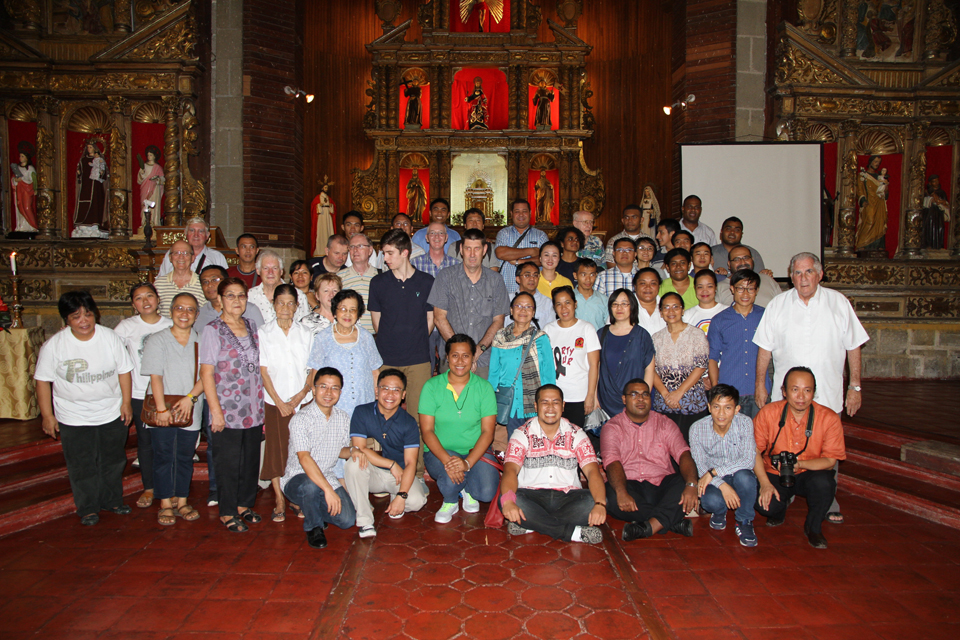
Some of the Pilgrims in Paete Church
As we continue to search for answers to the mystery of the death of Fr Vernon, we keep the attitude of faith that he himself embraced, expressed in the hymn used during Evening Prayer on the pilgrimage: Holy darkness, blessed night, / heaven's answer hidden from our sight. / As we await you, O God of silence, / we embrace your holy night.
Holy Darkness by John Michael Talbot
What the Pilgrims Say
Short Reflections on the Pilgrimage
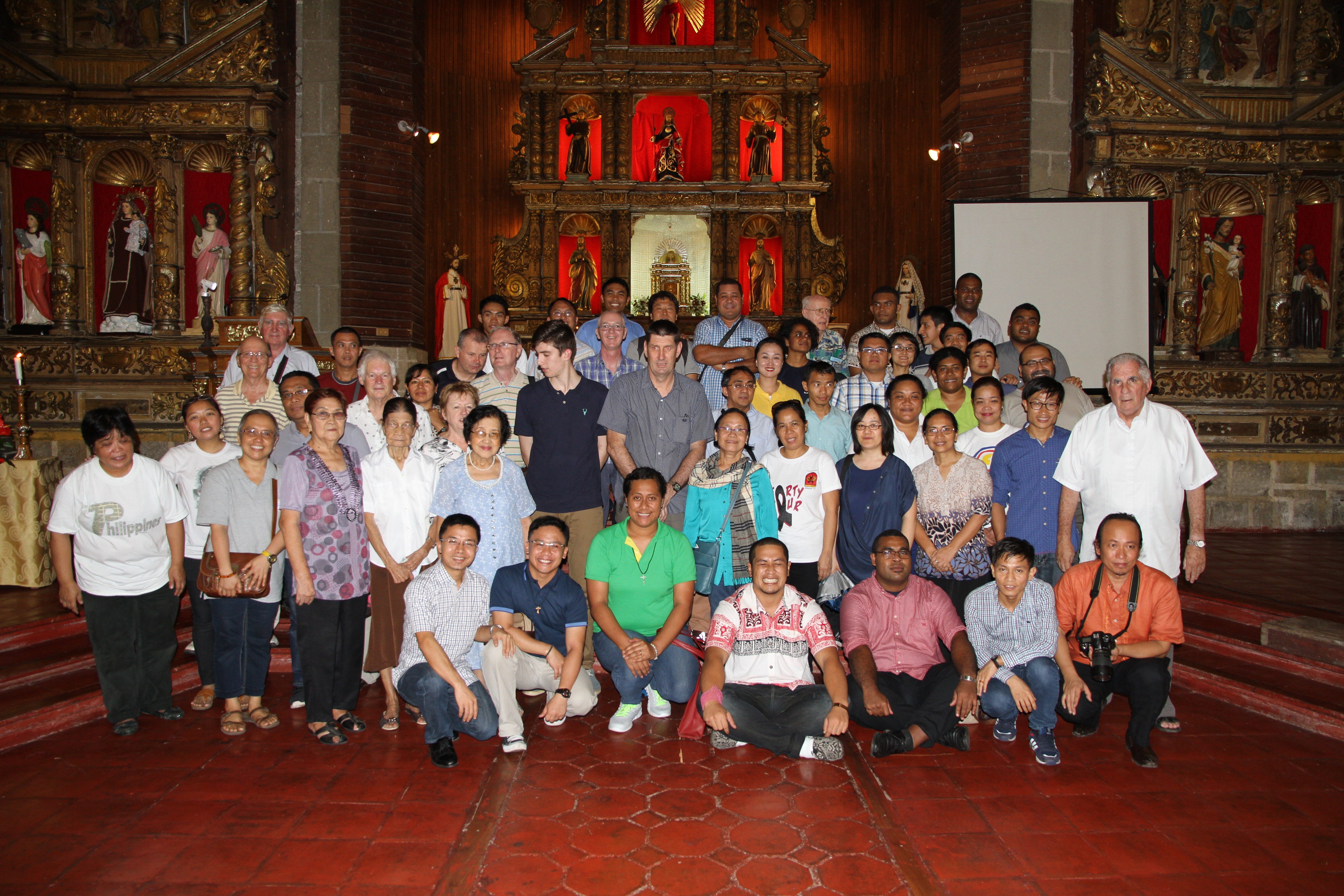
Some of the pilgrims
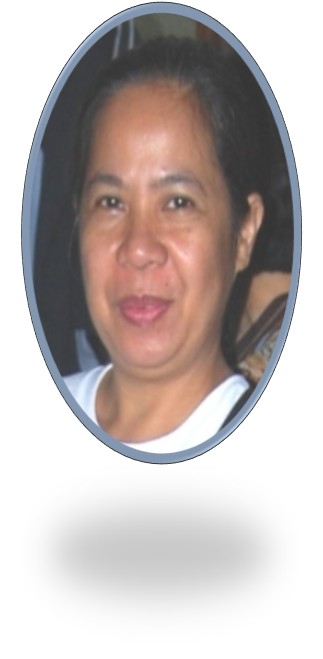 The experience was surreal. I felt sad yet honored, privileged, and blessed to have walked the floors that Fr Francis Vernon Douglas walked, touched the pillar where he was tied up and tortured, entered through the doors where he welcomed my fellow Filipinos, climbed the stairs where he was dragged out, and just being in the space where he once was. He is truly an inspiration. Mrs Mavic H. Mercene, Secretary, St Columban’s Lay Mission Center and of AITECE-Philippines.
The experience was surreal. I felt sad yet honored, privileged, and blessed to have walked the floors that Fr Francis Vernon Douglas walked, touched the pillar where he was tied up and tortured, entered through the doors where he welcomed my fellow Filipinos, climbed the stairs where he was dragged out, and just being in the space where he once was. He is truly an inspiration. Mrs Mavic H. Mercene, Secretary, St Columban’s Lay Mission Center and of AITECE-Philippines.

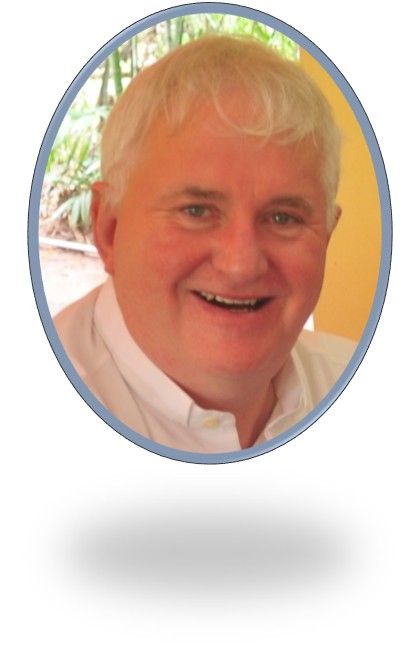 I found the sharing of the two witnesses very moving and inspiring. Although they were young when they witnessed Fr Vernon's suffering it impacted on their lives, and enriched their faith. Meeting them and listening to their sharing enriched my own faith and helped me make the connection with this great Columban. Fr Raymond Husband, Vice-Director, Region of the Philippines, and Rector, Columban House of Studies, QC.
I found the sharing of the two witnesses very moving and inspiring. Although they were young when they witnessed Fr Vernon's suffering it impacted on their lives, and enriched their faith. Meeting them and listening to their sharing enriched my own faith and helped me make the connection with this great Columban. Fr Raymond Husband, Vice-Director, Region of the Philippines, and Rector, Columban House of Studies, QC.

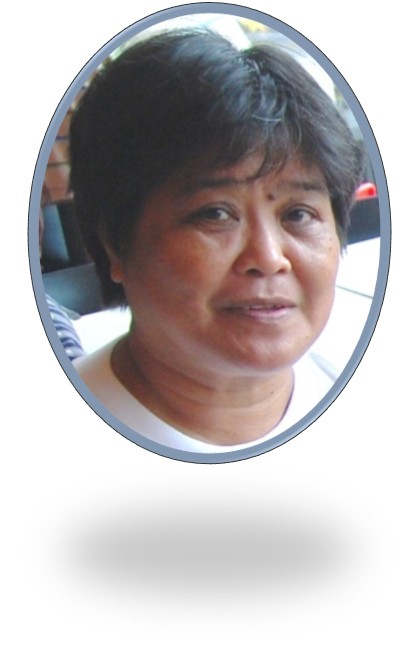 God's will comes in surprises. Believing and trusting God's providence, willingness to serve and sacrifice, the patience to wait, the goodness, cooperation and uniqueness of His people, and coming together walking with love, spirit and surprises in the direction of finding the true meaning of life is wonderful. We have nothing to worry about even unto death. I for one couldn't hold my tears, because God and Fr Douglas were with us, happy and joyful. Even the traffic in Manila and rain along the way couldn't stop us. Miss Thelma Patapat, Assistant Archivist, St Columban’s, Manila. Thelma is from Pililla.
God's will comes in surprises. Believing and trusting God's providence, willingness to serve and sacrifice, the patience to wait, the goodness, cooperation and uniqueness of His people, and coming together walking with love, spirit and surprises in the direction of finding the true meaning of life is wonderful. We have nothing to worry about even unto death. I for one couldn't hold my tears, because God and Fr Douglas were with us, happy and joyful. Even the traffic in Manila and rain along the way couldn't stop us. Miss Thelma Patapat, Assistant Archivist, St Columban’s, Manila. Thelma is from Pililla.

 Usa sa akong ginapuy-an nga versikulo gikan sa Matthew 20:26, ‘Rather, whoever wishes to be great among you shall be your servant’. Mao kana ang mga pulong nga akong ma-connect sa kang Fr Vernon upon hearing the testimomies sa mga katawhan. Nga samtang siya gitorture, anaa lamang siya sa kahilum samtang nagrosaryo. Diha sa kahilum, mas daghan pa kita’g mahunahuna nga mga bulawanong butang nga angay ikapa-ambit sa uban, sama sa atong mga talento ug gasa, aron daghan ang mabulahan. Daku kung kalipay nga nakasalmot sa gipahigayon nga pilgrimage isip pagbalik lantaw sa kinabuhing misyonero ni Fr Vernon. Usa ka maayong ehemplo nga pagasundon ug pagapuy-an sa atong inadlaw nga pagpakabuhi. Malipayon nga nakauban pud ang ubang mga Columbano. Jhan Yecyec, Columban Co-worker, Cagayan de Oro City.
Usa sa akong ginapuy-an nga versikulo gikan sa Matthew 20:26, ‘Rather, whoever wishes to be great among you shall be your servant’. Mao kana ang mga pulong nga akong ma-connect sa kang Fr Vernon upon hearing the testimomies sa mga katawhan. Nga samtang siya gitorture, anaa lamang siya sa kahilum samtang nagrosaryo. Diha sa kahilum, mas daghan pa kita’g mahunahuna nga mga bulawanong butang nga angay ikapa-ambit sa uban, sama sa atong mga talento ug gasa, aron daghan ang mabulahan. Daku kung kalipay nga nakasalmot sa gipahigayon nga pilgrimage isip pagbalik lantaw sa kinabuhing misyonero ni Fr Vernon. Usa ka maayong ehemplo nga pagasundon ug pagapuy-an sa atong inadlaw nga pagpakabuhi. Malipayon nga nakauban pud ang ubang mga Columbano. Jhan Yecyec, Columban Co-worker, Cagayan de Oro City.

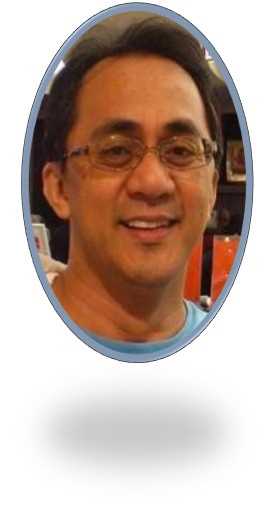 It was a great opportunity for me to have joined the Pilgrimage to Pililla and Paete. To be in the places where the drama of Francis Douglas's martyrdom unfolded was both sad and inspiring. To personally hear the testimonies of the two ladies who saw him tied to the post created a more visual reality that gave flesh to the stories I had heard from other people. The more touching the experience became when his nephew expressed his gratitude on behalf of the Douglas family and saw how they were touched by the way people in Paete honored their uncle all through the years. May Francis's life continue to inspire all of us and encourage us more to value the dignity and sanctity of our individual and collective vocation as Christians. Fr Jovito Dales, Bursar General, Hong Kong.
It was a great opportunity for me to have joined the Pilgrimage to Pililla and Paete. To be in the places where the drama of Francis Douglas's martyrdom unfolded was both sad and inspiring. To personally hear the testimonies of the two ladies who saw him tied to the post created a more visual reality that gave flesh to the stories I had heard from other people. The more touching the experience became when his nephew expressed his gratitude on behalf of the Douglas family and saw how they were touched by the way people in Paete honored their uncle all through the years. May Francis's life continue to inspire all of us and encourage us more to value the dignity and sanctity of our individual and collective vocation as Christians. Fr Jovito Dales, Bursar General, Hong Kong.

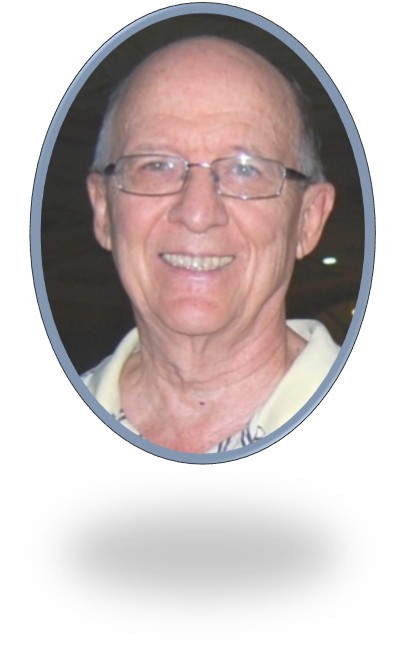 I was deeply moved by the testimonies of Mrs Aurelia Cadapan and Miss Dominga Bayocot who, as youngsters, witnessed the torments of Fr Vernon Douglas. While they were bringing food to their relatives who were also imprisoned in their church Aurelia and Dominga remembered seeing Fr Vernon tied to a pillar that supported the choir loft. He was bruised and bleeding from a head wound. In telling their stories the two women, now in their late 80’s, mentioned details that attested to the accuracy of their memories. Dominga remembered that her mother made her wear tattered clothes so as not to attract the attention of the soldiers. Aurelia remembered how deeply she had to bow to the Japanese guards before passing into the church. They gave their testimonies before we visited the church where Fr Vernon was tortured. Upon entering we saw the pillar to which Fr Vernon had been tied. Next to it a tiny candle kept vigil over that sacred place. Fr Vincent Busch, Ozamiz City.
I was deeply moved by the testimonies of Mrs Aurelia Cadapan and Miss Dominga Bayocot who, as youngsters, witnessed the torments of Fr Vernon Douglas. While they were bringing food to their relatives who were also imprisoned in their church Aurelia and Dominga remembered seeing Fr Vernon tied to a pillar that supported the choir loft. He was bruised and bleeding from a head wound. In telling their stories the two women, now in their late 80’s, mentioned details that attested to the accuracy of their memories. Dominga remembered that her mother made her wear tattered clothes so as not to attract the attention of the soldiers. Aurelia remembered how deeply she had to bow to the Japanese guards before passing into the church. They gave their testimonies before we visited the church where Fr Vernon was tortured. Upon entering we saw the pillar to which Fr Vernon had been tied. Next to it a tiny candle kept vigil over that sacred place. Fr Vincent Busch, Ozamiz City.

 I had known about Fr Douglas since I had worked in eastern Rizal in the 1990s but it was mostly on an 'informational' and individual level. The pilgrimage to Pililla and Paete in a Columban group that was multi-cultural, multi-generational and in the company of his immediate relatives brought home to me the sacredness of his sacrifice and how relevant and alive is his witness in the context of Columban mission today. Fr John Leydon, Malate Parish.
I had known about Fr Douglas since I had worked in eastern Rizal in the 1990s but it was mostly on an 'informational' and individual level. The pilgrimage to Pililla and Paete in a Columban group that was multi-cultural, multi-generational and in the company of his immediate relatives brought home to me the sacredness of his sacrifice and how relevant and alive is his witness in the context of Columban mission today. Fr John Leydon, Malate Parish.

 The pilgrimage awakened my awareness of the multiple possibilities in my life as a missionary, depending on what the situation calls me to do. It was both a privilege and a joy that my faith in God was nourished. And my belief that the calling that have I responded came from God and not from myself was deepened. For this, I would like to ask Fr Vernon to help me to be faithful, just as he was, to the mission regardless of the possible consequences. Jerry Lohera, Columban seminarian from Magsaysay, Misamis Oriental.
The pilgrimage awakened my awareness of the multiple possibilities in my life as a missionary, depending on what the situation calls me to do. It was both a privilege and a joy that my faith in God was nourished. And my belief that the calling that have I responded came from God and not from myself was deepened. For this, I would like to ask Fr Vernon to help me to be faithful, just as he was, to the mission regardless of the possible consequences. Jerry Lohera, Columban seminarian from Magsaysay, Misamis Oriental.

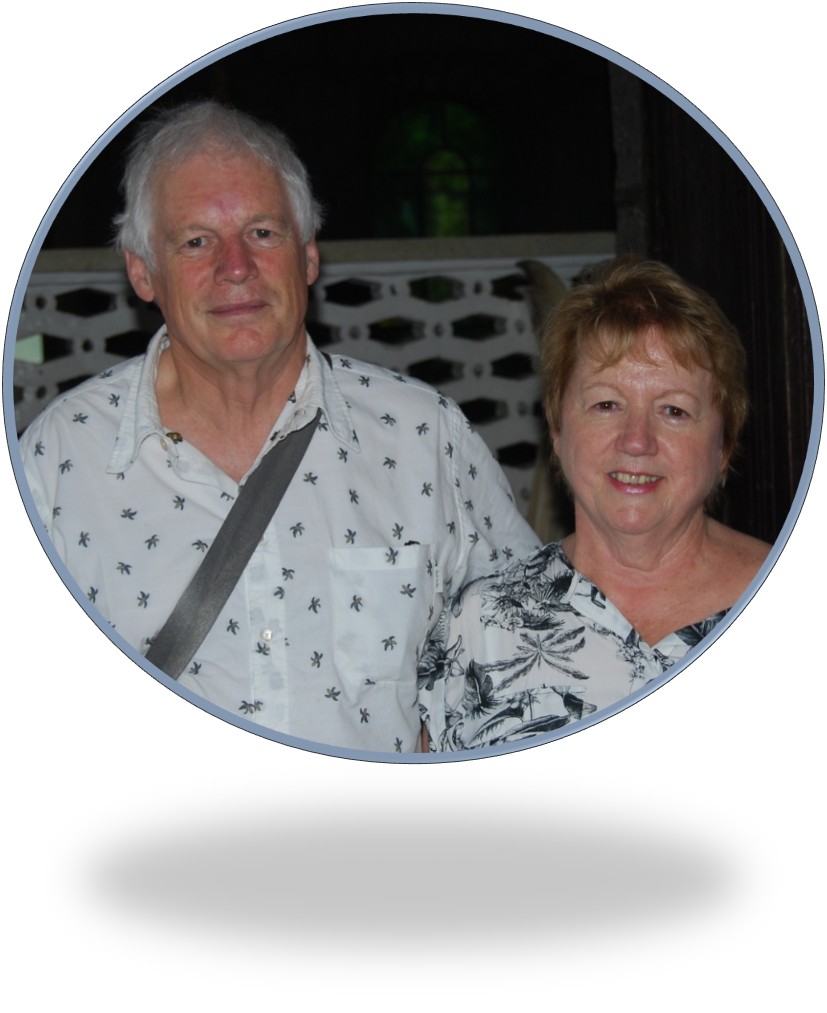 The pilgrimage was so special, you all shared our pain and joy. This has been the greatest journey I have ever made. Without your planned pilgrimage it would not be the same. I feel Uncle Vernon smiling on us all, I feel he can surely rest in peace now. Thank you all for this wonderful experience. God Bless. Verne Rose, Fr Douglas's niece, with her husband Cliff Turner, New Zealand.
The pilgrimage was so special, you all shared our pain and joy. This has been the greatest journey I have ever made. Without your planned pilgrimage it would not be the same. I feel Uncle Vernon smiling on us all, I feel he can surely rest in peace now. Thank you all for this wonderful experience. God Bless. Verne Rose, Fr Douglas's niece, with her husband Cliff Turner, New Zealand.
FIJI/ TONGA TEAM 11
COLUMBAN LAY MISSIONARIES
The three members of Fiji/Tonga Team 11 of the Columban lay Missionaries arrived in the Philippines on 28 December 2015 and flew two days later to Cagayan de Oro where they celebrated the New Year of 2016. On 4 January they began a six-month course in the Cebuano language at the Maryknoll Institute of Language and Culture, Davao City. They are now assigned in Barra, Opol, Misamis Oriental, where their Columban companions are Fr Paul Finlayson from New Zealand and two Peruvians, Fr Enrique Escobar and lay missionary Ana Belma Flores. Haiti and Liliani are from Tonga while Vasemaca is from Fiji. The Columbans have been in Fiji since 1952. Despite the fact that we have never worked in Tonga we now have both priests and lay missionaries from that island nation.
The three joined the Columban Lay Missionaries Accompaniment Program in 2014 and the nine-month Orientation Program last year. The latter included the first quarter (three months) of Clinical Pastoral Education (CPE).
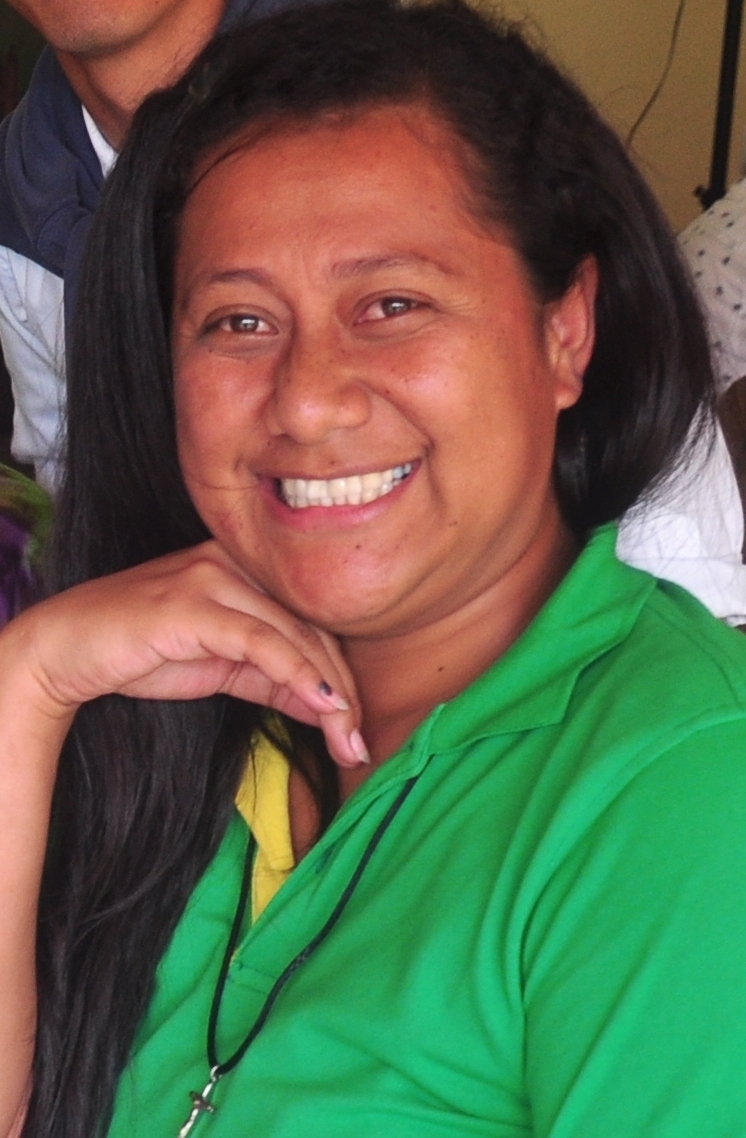 Haiti Müller.
Haiti Müller.
Haiti was born on 10 May 1986 and hails from Hihifo Parish, Tonga. She studied at the Government Primary School of Fatai, APi Foou College and Ahopanilolo Technical College studying- Commercial Cookery and Catering.
She worked as a Mary Potter volunteer and was a novice in the Little Company of Mary. She is the daughter of Kauulu Fonua and Mele Kaneisini Müller and is the youngest in the family. Her mother passed away in 2013. Her Dad lives in Tonga. She comes from a strong Catholic family.
Haiti is open and talkative. She is gifted with her hands, very good in creative liturgy. She has completed her 2nd quarter of Clinical Pastoral Education (CPE). She likes cooking and singing. When Haiti was a novice of the Little Company of Mary she was sent to Manila. Her motivation for mission is to serve God and others.
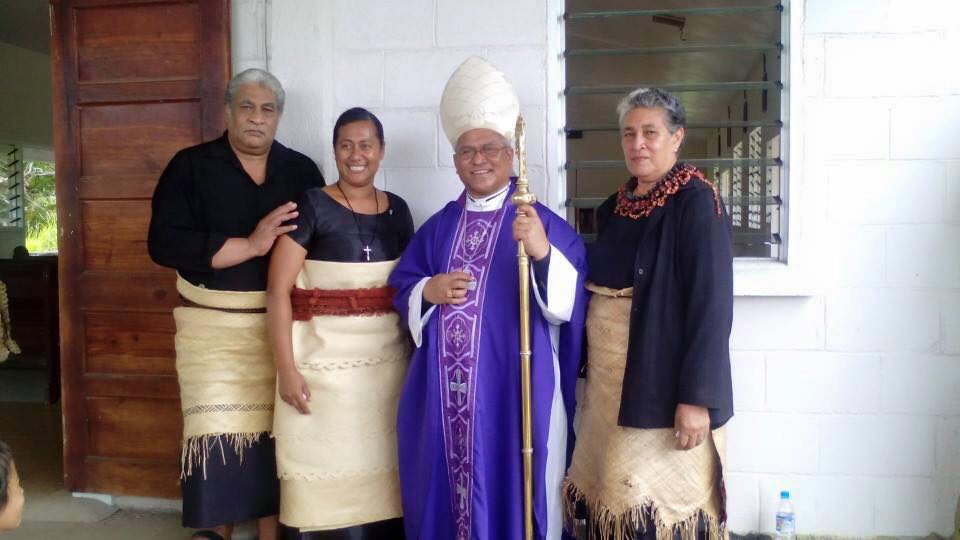
Haiti with family members and Cardinal Mafi, Bishop of Tonga
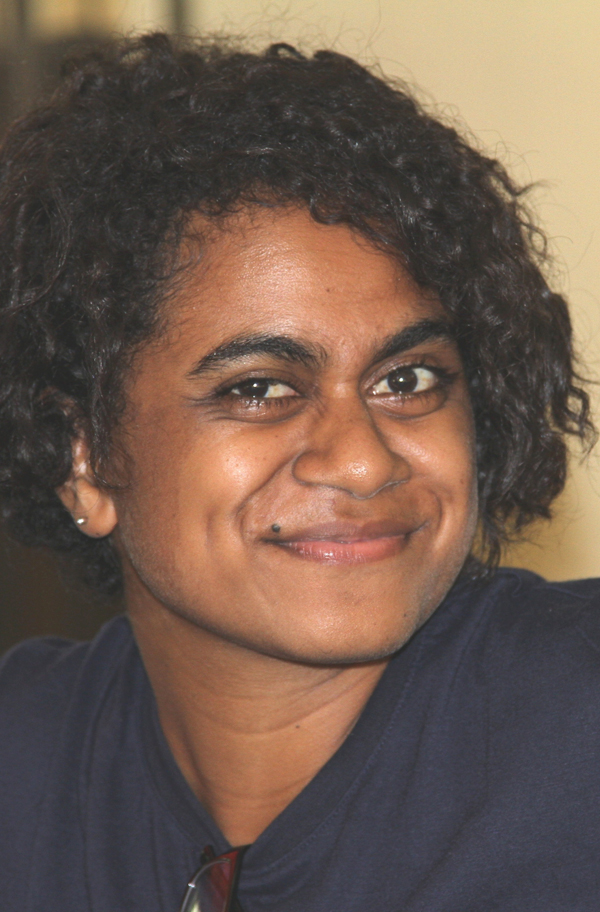 Vasemaca Rokotukana Ratu.
Vasemaca Rokotukana Ratu.
Vasemaca, ‘Va’, is a member of St Agnes Parish, Samabula, and hails from Vuaki, Yasawa, Fiji. She was born on 4 August 1990 and the youngest daughter of Venasio and Mereoni Ratu. She comes from a strong Catholic Family. She studied at Nasomolevu Catholic School, Jasper Williams High School and Fiji National University where she studied Electrical Engineering. She worked as a technician.
Vasemaca likes singing and playing the guitar. She wants to help the poor and persons with disabilities.
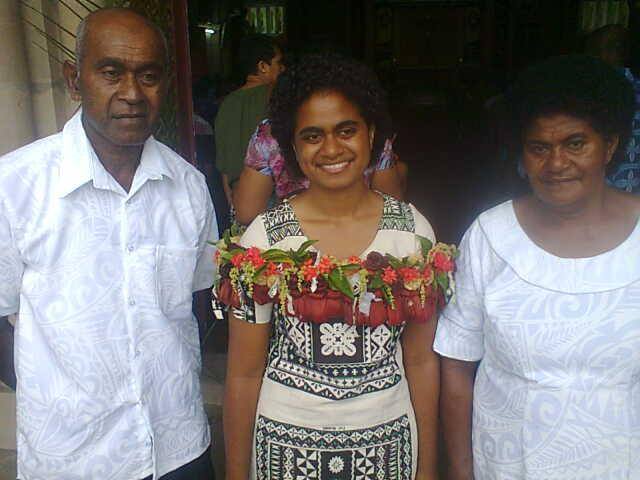
Vasemaca with her parents Venasio and Mereoni
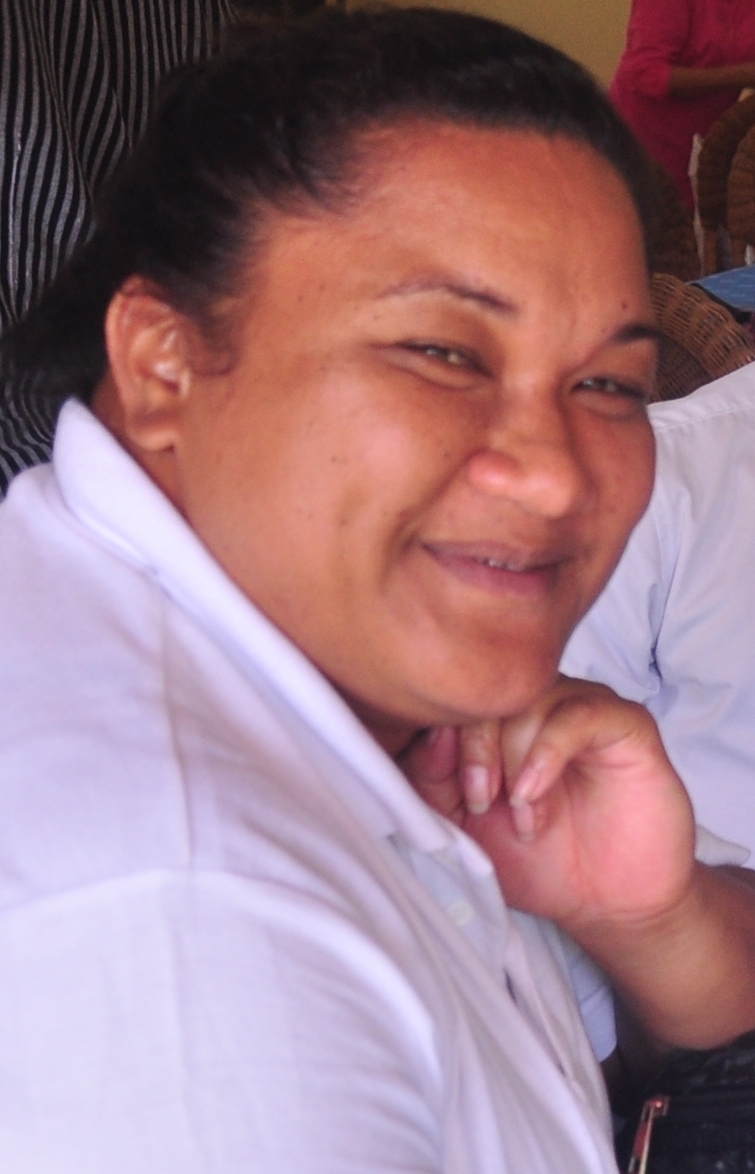 Liliani Losi Ma’afu.
Liliani Losi Ma’afu.
Liliani was born on 1 April 1986 and is the daughter of Sikifi and Ateliana Ma’afu. She hails from Lapaha, Tonga. Her Dad has passed away. She is the fourth of eleven siblings. She comes from a family of seven sisters and four brothers.
She studied at the Government Primary School of Mu’, Takuilau College and St Joseph Business College where she took Secretarial and Computer Studies. She worked as a secretary for the Youth in the Diocese of Tonga.
Liliani has good computer skills. She loves to play netball and to cook. She wants to work with the poor.
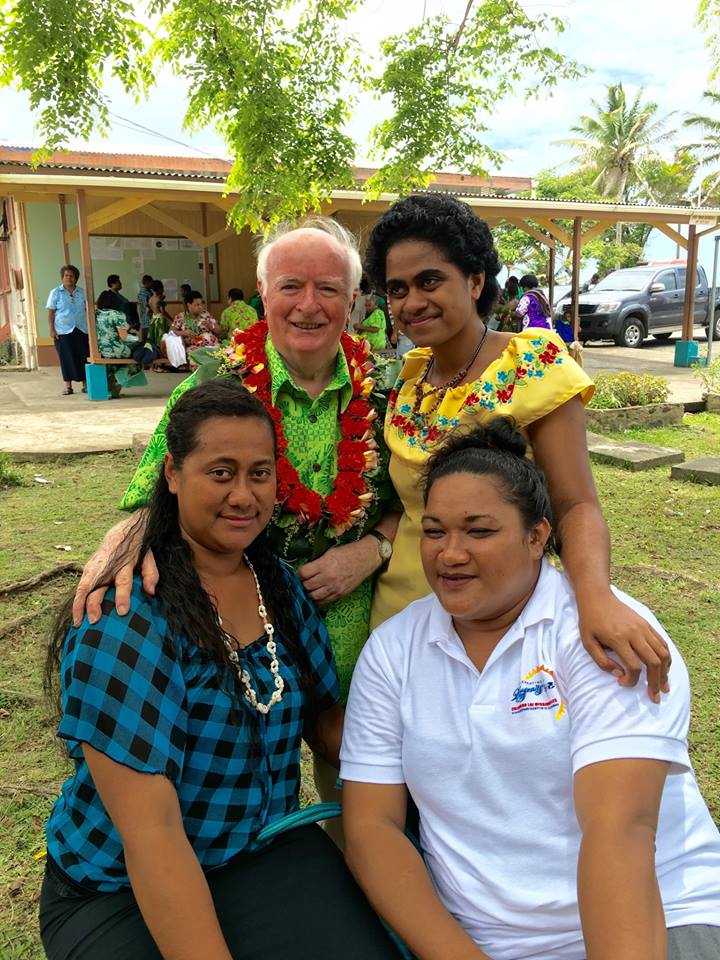
Fr John McEvoy with Vasemaca (back) Haiti (L) and Liliani
Our Hideaway
Forgiving enemies is not so easy
An interview with Christina Shabo
This article was first published in the 21 August 2016 issue of Sunday Examiner, the English-language weekly of the Catholic Diocese of Hong Kong edited by Australian Columban Fr James Mulroney.

Pope Francis at World Youth Day 2016 [Wikipedia]
 KRAKÓW (SE): ‘I asked Jesus for the grace to forgive every time I prayed the Divine Mercy Chaplet. But instead of praying “For the sake of his sorrowful Passion, have mercy on us and on the whole world,” I prayed “have mercy on the Islamic State and on the whole world”,’ Christina Shabo, who was born under a tree in a refugee camp after her family fled the bombing in Iraq in 1991, said in a testimony on 29 July at World Youth Day in Kraków, Poland.
KRAKÓW (SE): ‘I asked Jesus for the grace to forgive every time I prayed the Divine Mercy Chaplet. But instead of praying “For the sake of his sorrowful Passion, have mercy on us and on the whole world,” I prayed “have mercy on the Islamic State and on the whole world”,’ Christina Shabo, who was born under a tree in a refugee camp after her family fled the bombing in Iraq in 1991, said in a testimony on 29 July at World Youth Day in Kraków, Poland.
However, she told CNA that in fact nothing is that simple, because when she was first asked to share her experiences and incorporate something about forgiveness, her only thought was, ‘I do not forgive the Islamic State.’ The 25-year-old explained, ‘I’ve struggled with it, because I have not got there yet. I don’t forgive the Islamic State. It is a daily reminder,’ she continued, pointing out that she still harbors anger and resentment.
‘I was a miracle baby. I truly was,’ she said, telling how her mother was eight months pregnant when her family made the decision to flee the bombing during the Gulf War in 1991. They joined thousands of their neighbors on the long trek to Turkey, spending much of the time in fear as bombs fell around them. Christine explained that her eight-year-old cousin, Rita, was among those who perished along the way, but her father did not have the heart to bury her in the mountains and carried her dead body all the way into Turkey. However, the Shabo family did make it and pitched camp under a tree where, after a month, her mother gave birth. Two years later her family was given asylum in the USA and settled in Detroit.
WYD 2016, Kraków
But while the little world of her immediate family was cozy, the big world of violence Christine had been born into was reincarnated on 20 June 2014 when the Islamic State stormed Mosul, Iraq, slaughtering both Christians and Muslims who did not share its extreme ideologies. She said one of her relatives was ‘violently murdered . . . He was chopped up in a dozen pieces’ and delivered to his family in a bag. ‘Imagine someone that you love being delivered to you in a bag in pieces. It is insane. So when I hear stories like that, how could I not be angry?’ she queried. One of her cousins was also killed in Baghdad and her cousin’s mother, at the time of writing, was still in the hospital fighting for her life.
The young Iraqi said that in the middle of all that, it is hard to think of forgiveness, but throughout her life whenever she has felt anguish, anger, frustration or numbness, ‘I go to adoration. I take it to him.’ She explained that was where the idea of praying for the Islamic State came to her mind. ‘It just kind of came to me; pray for them . . . but think about them in a more positive way,’ she reflected. She said that in all truth, her initial thought was ‘fake it till you make it’ but eventually she was able to let go of some of her anger.
Iraqi pilgrims at WYD 2016
But, she explained that there is a sense of guilt that goes along with the blessing of living in Detroit, where she can live like a normal person, except for the guilt that comes from knowing the rest of her family did not make it. ‘None of my other family survived. There’s a sense of guilt that I survived and they didn’t,’ she said, explaining that she also feels a deep connection with the Christians in Iraq and desperately wants to go back.
She tries to keep her Aramaic roots and struggles with the language as it is the one that Jesus Christ spoke, and a Middle East without Christians would be a tragedy she cannot contemplate. ‘That can’t happen. I don’t want to see that happen. I don’t want to live in that world,’ she said.
She has found being at World Youth Day a real privilege. ‘As powerless as you feel as an individual, when you connect with other people who have that same passion that have that same desire, God works wonders,’ she said. ‘It is good to know that other people are listening and connecting with the story,’ she concluded.
WYD 2016 anthem in Arabic
The English text on the video is not a translation of the words of the song but a reflection on the reality of so many refugees from conflicts in the Middle East, especially in Iraq. May the video remind us that the very oldest Christian communities are in Iraq and its neighboring countries and that the vast majority of our brothers and sisters in those communities are Arabs.
Parenting Parents
By Mary Joy Rile
This article first appeared earlier this year in issue 25 of Columban Mission, the 12-page newsletter published three times a year by the Columbans in the Philippines. Necita’s Tatay, Nieto, has since died, on 20 October. The light of heaven upon him.
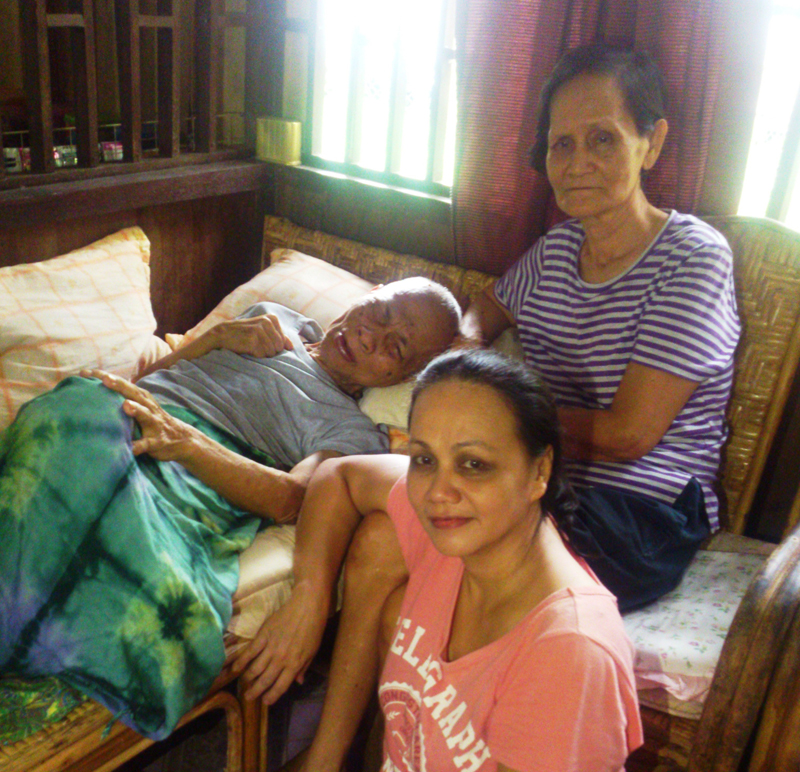
Necita Fetalvero with her parents Nieto and Lucita
I was privileged in November 2015 to join a group of Columban lay missionaries (CLMs) and the Columban vocation team in visiting former CLM Necita Fetalvero and her parents Nieto and Lucita in Tubod, Lanao del Norte. Seeing the family for the first time tugged at my heart, not just because both parents are aging – with Tatay paralyzed for 25 years from a stroke and bedridden since last year and Nanay with diabetes and due to have a cataract removed – but because they are a symbol of a resilient family. As we listened to their love story Nanay’s humor was noticeable. We enjoyed it when she responded with jokes. We recognized that that’s one of the ways she copes with all the challenges she’s been facing over the years. Tatay is her first and last love. Despite the hardships, Nanay is not giving up on Tatay till death do them part.

Cita told us about her usual routine. She is often awakened at midnight when Tatay asks her for something or when he can’t sleep. Nanay in her excitement tends to forget the doctor’s advice but Cita makes sure everything is monitored. It’s quite difficult for her, an only child, with both parents needing medical attention.
Cita, who was a CLM in Korea from 2002 until 2011, shared something quite remarkable with me.
When I was on mission in Korea the whole night was for resting but now it’s different. I’ve realized that when you're home for a family mission to look after aging and sick parents it’s a 24-hour commitment. Bawat hininga, bawat galaw kasama sila. But it’s a blessing to accompany them in their twilight years. They’ve given me the gift and opportunity of being a parent to them. Tatay has given me the opportunity to experience being a ‘father’ when I take charge of household needs and decision-making. Nanay has given me the opportunity to be a ‘mother’. Through the years she has stood beside Tatay and I am there to listen to and affirm her and to take care of her each moment as a mother to her. What a beautiful gift, Joy.
Not everybody can have this gift in their lifetime. We are blessed to have this gift and its challenges. But it’s never easy. What sustains me aside from love is the grace to see things with a father's eyes and to touch them with a mother's heart. I am also deeply touched and amazed as I witness how love has transformed their lives together in those difficult years until their twilight years. But I feel blessed to witness this. Joy, thank you. In our lifetime we share the same joys and struggles of that gift. Again, it is love. My strength may be exhausted but the love that I can give will never be depleted. I know you are also like that. Sharing with you the blessings of this mission, Joy.
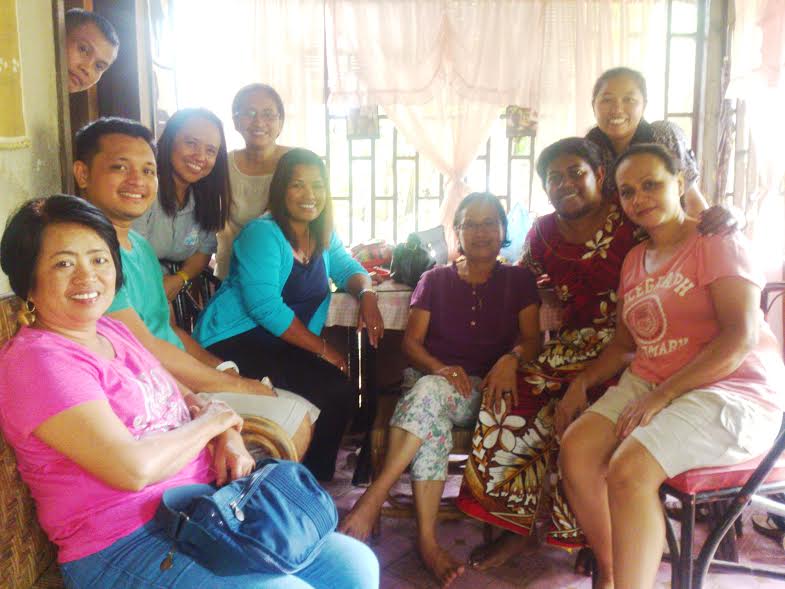
Necita (far right), Joy Rile (behind Necita) with Columban Lay Misisonaries and co-workers
I felt so at home when we visited the Fetalvero family. Meeting them was a touching, powerful experience, so powerful that it became my inspiration when I returned to Bacolod. I have something in common with Cita – she is taking care of both her aging parents, while I am taking care of my aging mother, Mama Lanie, and maternal grandmother, Lola Maring. Before talking to Cita, I was confused about what to do with my life. Meeting her called me to an intense discernment between a lifetime commitment and choosing to serve my family. I am single and can opt to live as I want and be concerned with my own well-being. But learning from Cita’s experience, I know I am on the right track facing the choice between continuing with a life I desire and being a missionary to my own family.
I’m keeping an open line with Cita about parenting parents and trying to differentiate between ‘caring for’ and ‘parenting’. At times you have to struggle to win your parents over just to get them to eat. At times you have to struggle and be creative just to be understood. It’s not that your parents are at your mercy but that sometimes you have the responsibility of deciding what’s best for them, as they did before for you. While attending to their medical needs you have to meet other needs such as keeping the house tidy. You have to be a homemaker, as Cita would say. You have many sleepless nights and many times have to be patient with them even while fighting your own sense of helplessness. It’s as if the parent-daughter roles have been switched.
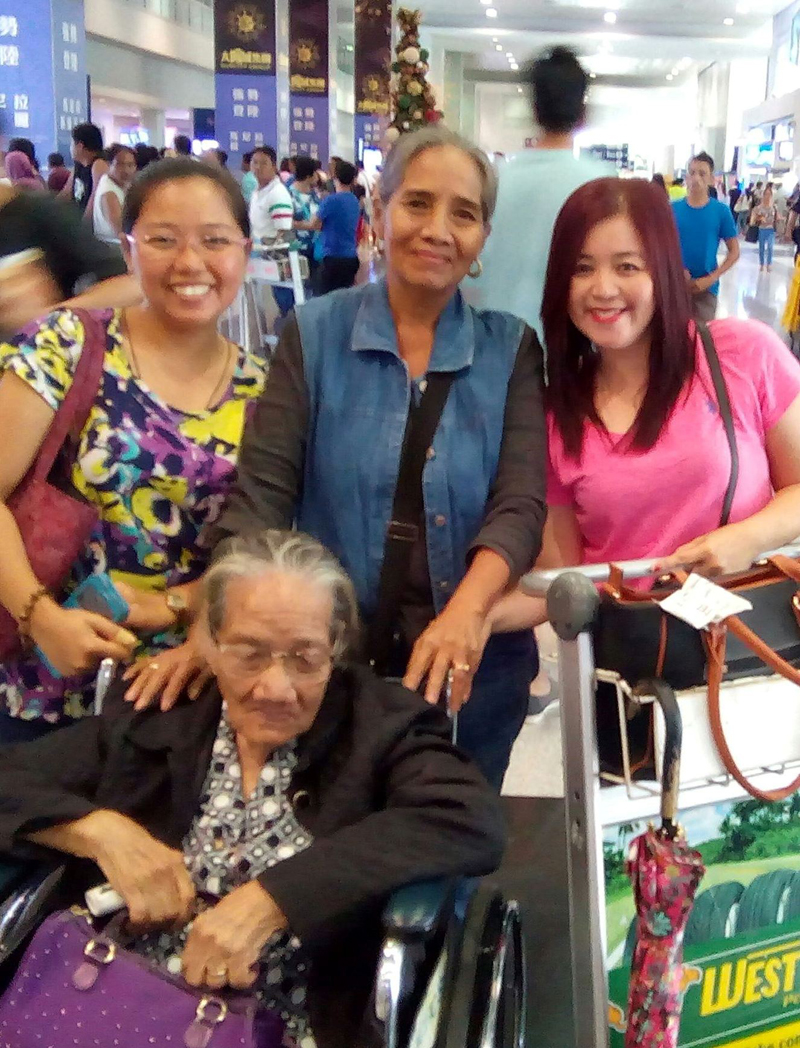
Joy Rile with her Mama Lanie, eldest sister Cristina and Lola Maring
Let's journey together, Cit. Knowing that someone else is sharing in our passion is a comfort and encourages us to keep going. So amazing and beautiful is the grace that comes from God! This is grace, to be one in this mission with you, though at a distance. God's grace speaks the same language as He puts us in similar situations. Thank you gid, Cit. Thank God for the love, teaching us to love also. Padayon ta. Aja!
I have my share of parenting a parent. That’s why my heart was captured by Cita’s story and I thank her for generously sharing it. I am learning from her experience. I was called to serve in a community for seven years. But now I am called to serve my own family. Yes, I just have to come home this time.
* * * * * *
WINGS
By Necita FetalveroAs the night
darkens the sky
I come to the edge
to step into the darkness
of the unknown
I let my gaze wonder with
‘Wings of Faith’
where light takes
the place of darkness.As the road unveils
the risk of the journey
seeing an ever-widening
landscape
and all familiar landmarks
vanish
Then only in the
‘Wings of Trust’
shall I find refuge
and strength.As the mystery of
life and love unfolds
in each passing
blissful moment
the heart takes its
‘Wings of Love’
expanding to the fullness
of becoming and growing
through time and space.As the wind
carries the love
to the infinite ocean
outstretched
‘Wings of Freedom’
will soar above and beyond
where they are meant to be.Gazing into the sky
above the distant land
the ‘Wings of my Heart’
will grow and spread out
to its fullest extent
to become
what they are meant to be.
* * * * * *
Peace By Peace
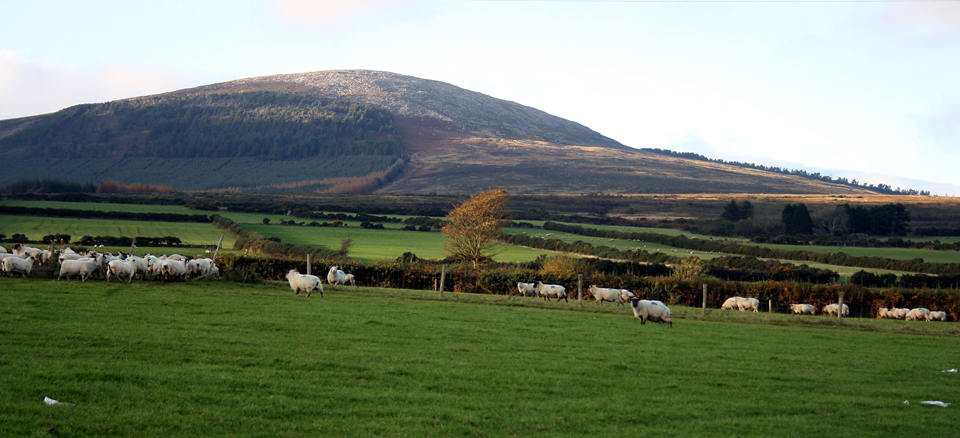
Black Rock Mountain, southeast Ireland [Wikipedia]
St Columban (c.543 – 23 November 615) is believed to have been born near here.
Sweet joys of life
May Christ, the Ruler of the Universe,
the only Son of the All-powerful,
grant you all the sweet joys of life,
who, without end, governs all things,
in the name of his Father. Amen.
– Prayers and Sayings of St Columban, Columban Martyrs of Malate, 1995
+++
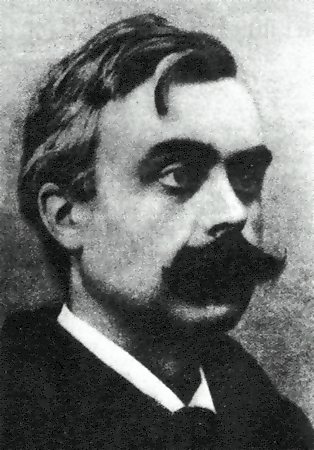
Léon Bloy in 1887 [Wikipedia]
The worst evil is not to commit crimes, but to have failed to do the good one might have done.
– Léon Bloy, Pilgrim of the Absolute (1846 – 1917)
+++
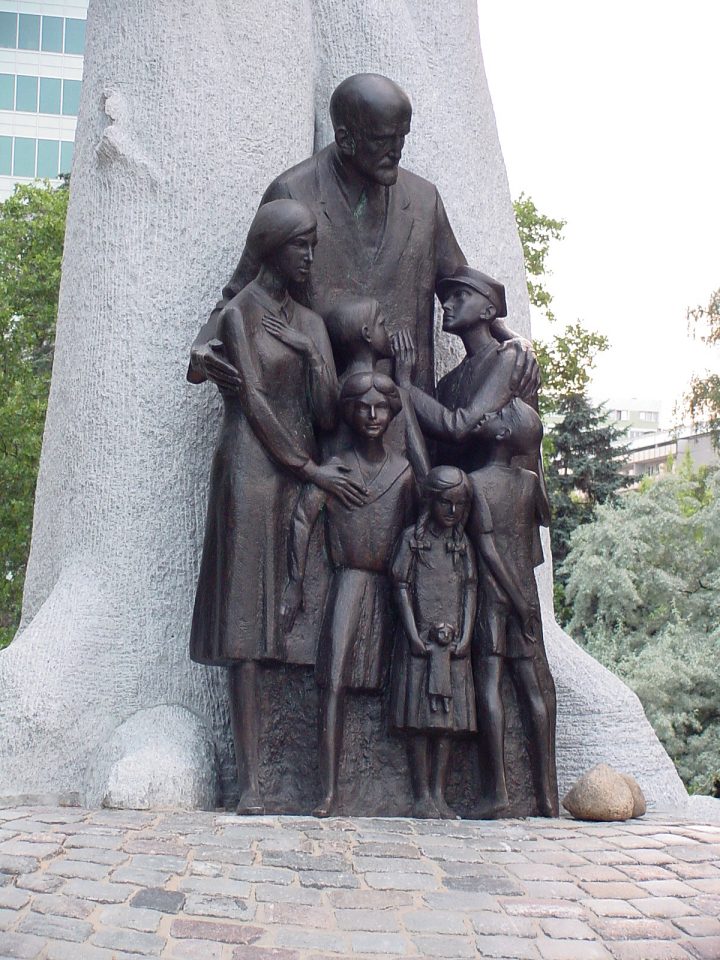
Janusz Korcsak Monument, Warsaw [Wikipedia]
Allow children to make mistakes and to joyfully strive for improvement. Children love laughter, running about, and playing tricks. If your own life is like a graveyard to you, leave children free to see it as a pasture. If you witness a child’s happiness in all its intensity, then you cannot fail to notice that the highest level of joy results from having overcome some obstacle – from a goal attained or a mystery solved.
– Janusz Korczak (1878 – 1942) [Source]
+++
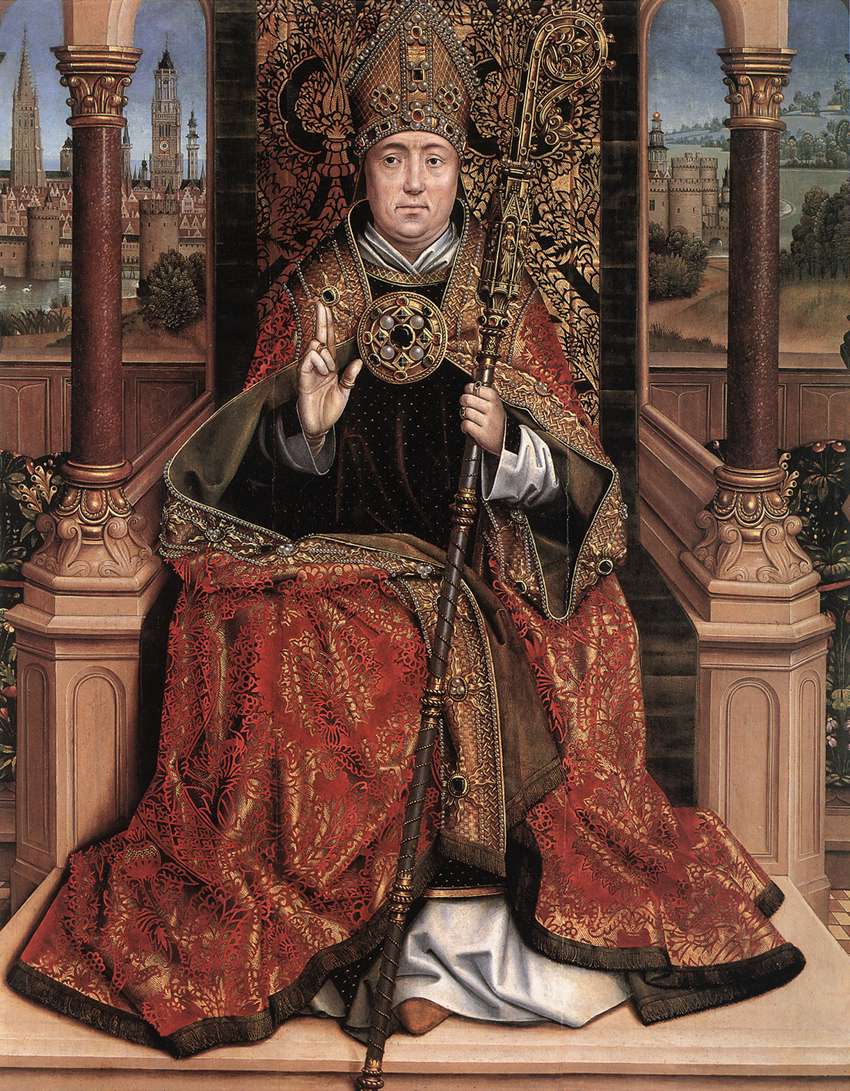
St Nicholas Altarpiece (central panel), Master of the Legend of St Lucy, 1486-03
Groeninge Museum, Bruges/Brugge, Belgium [Web Gallery of Art]
The giver of every good and perfect gift has called upon us to mimic Gods giving, by grace, through faith, and this is not of ourselves.
– St Nicholas of Myra (15 March 270 – 6 December 343)
+++
The True Peace
Black Elk (1863 – 1950) was baptized as a Catholic in 1904 after the death of his first wife, Katie War Bonnet, a Catholic. He took the name ‘Nicholas’, after St Nicholas of Myra (above) as his baptismal name. He also became a catechist.
The first peace, which is the most important, is that which comes within the souls of people when they realize their relationship, their oneness, with the universe and all its powers, and when they realize that at the center of the universe dwells Wakan-Taka (the Great Spirit), and that this center is really everywhere, it is within each of us.
This is the real peace, and the others are but reflections of this. The second peace is that which is made between two individuals, and the third is that which is made between two nations. But above all you should understand that there can never be peace between nations until there is known that true peace, which, as I have often said, is within the souls of men. [Source]
– Black Elk - Oglala Sioux
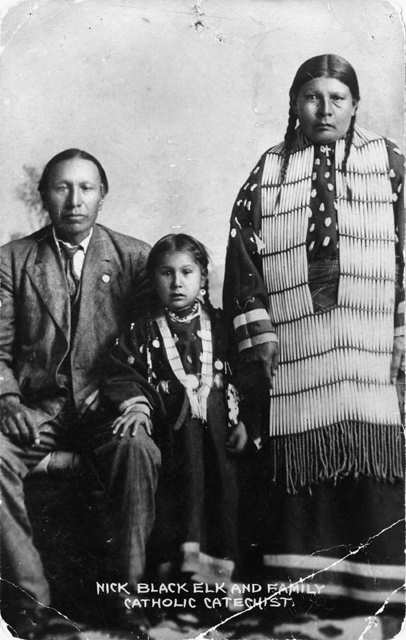
Black Elk, daughter Lucy Black Elk, and second wife Anna Brings White, South Dakota, c. 1910 [Wikipedia]
+++
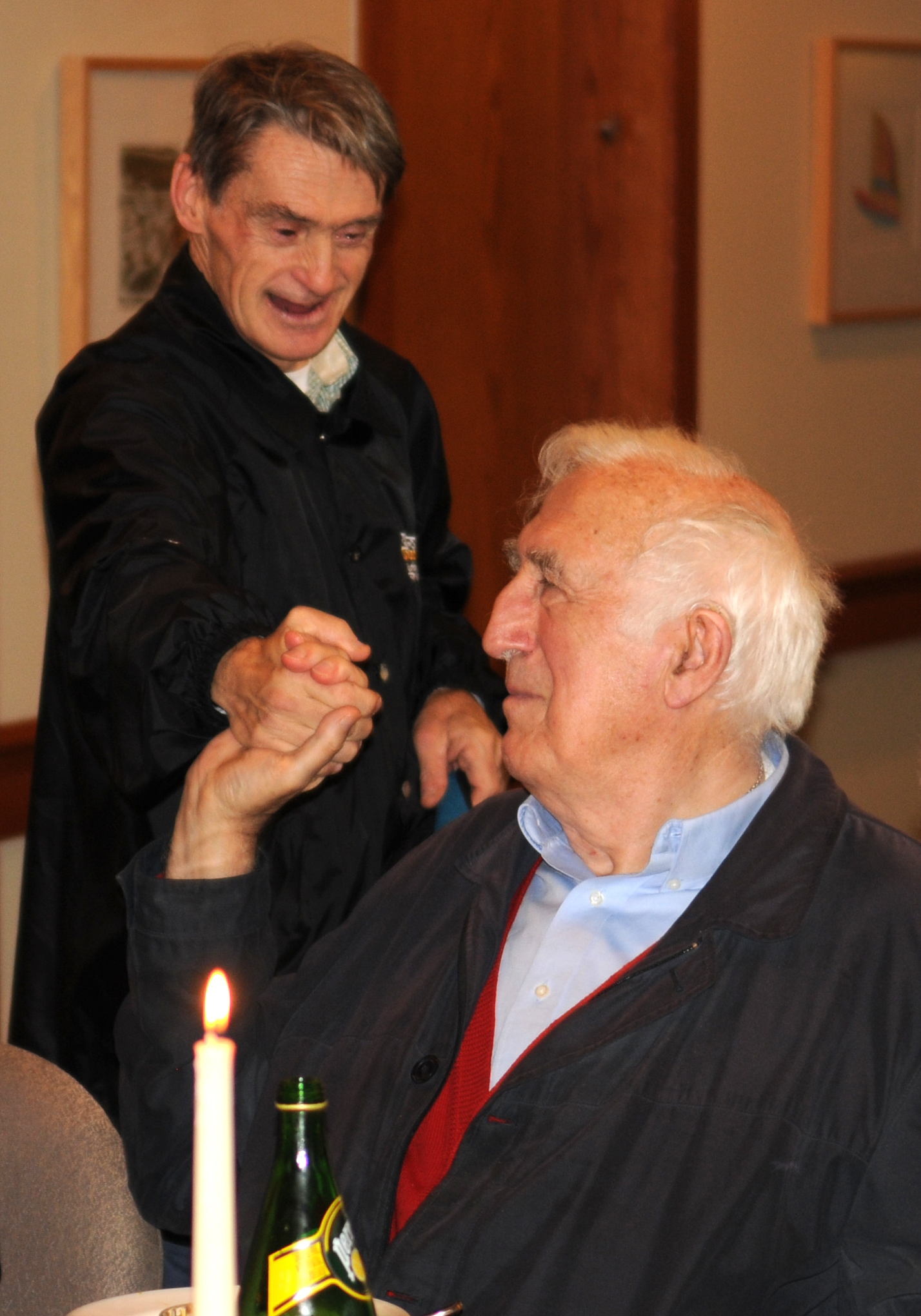
Jean Vanier (R) with John Smeltzer, L’Arche Daybreak, Toronto 2009 [Wikipedia]
For peace, people must meet across differences. I say to meet people, not just to send them money and offer better professionals. All need to change. Fear must be changed into openness. Those on the rich side need to change and open their hearts to those on the other side. Those on the needy side also need to change; from anger, anguish, depression and a sense of being victims of a society, they must become agents of hope and of love . . . It is only as we meet and share together person to person, eye to eye, and heart to heart that we discover what it means to be human and to discover the joy of being together, working together towards a common mission of peace and unity. It is only moving from winning and loneliness to collaboration, and from hostility to seeing enemies as friends, that we discover the real meaning of peace.
– Jean Vanier [Source]
+++
Scroll of the Book of Isaiah [Wikipedia]
O Lord, you will ordain peace for us,
for indeed, all that we have done, you have done for us.
– Isaiah 26:12
+++
Pulong ng Editor
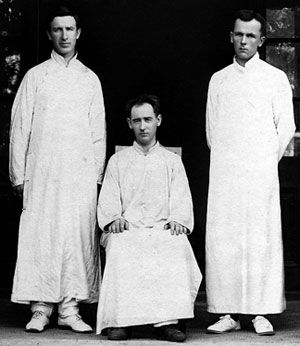
Co-founders Fr Edward Galvin and Fr John Blowick (seated) with Fr Owen McPolin, China 1920
On Sunday 9 October this year 31 priests and 16 lay missionaries went to Tagaytay City for a two-week meeting of Columbans under the age of 50. Among them was our Superior General, Fr Kevin O’Neill, who in a recent letter wrote: On 9 October 1916, in a ground-floor room of the main college building at Maynooth [St Patrick's College, the National Seminary of Ireland], the 28-year-old Fr John Blowick had the nerve to face the Standing Committee of the Irish Bishops and to present his and Fr Edward Galvin’s scheme for a new mission. After about half an hour’s talk with the bishops, [Michael] Cardinal Logue [Archbishop of Armagh] said that they were prepared to grant their approval for the two things Blowick requested, namely, the making of a collection in the country and the foundation of a Mission College in Ireland.
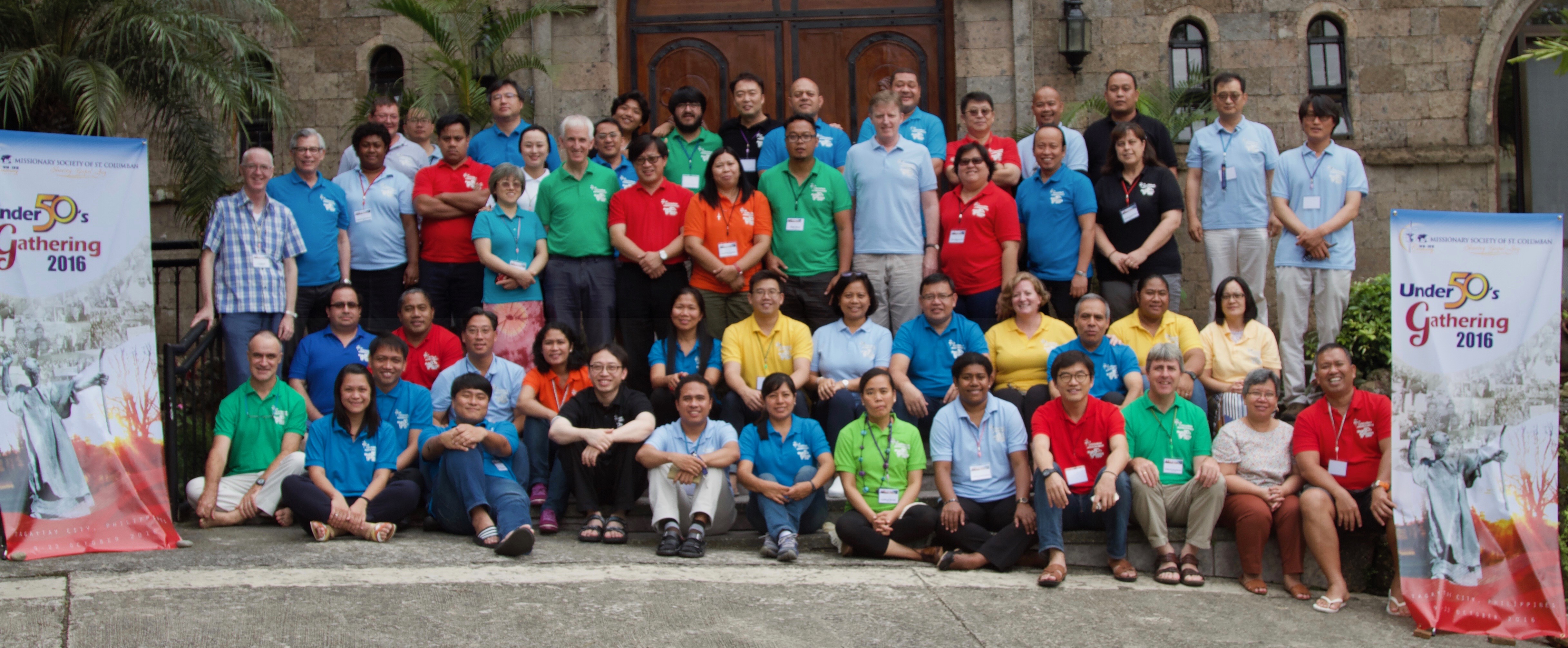
Under 50s' meeting of Columbans, Tagaytay City
That approval came the following day, 10 October 1916, exactly 100 years before the Columbans in Tagaytay City had their first full day of business. Fr O’Neill wrote: The ‘memorial’, drawn up by a committee of prominent clerics, was laid before the full body of the bishops on 10 October 1916 informing them that: ' . . . a vigorous movement, of which the heart is Maynooth College, has grown up among young Irish ecclesiastics to go forth and carry the light of the Gospel to the Chinese . . . The bishops rejoiced and were thankful to God for this new and striking evidence of the continued life of the ancient Irish missionary spirit.' After careful consideration the bishops approved the project.
This ‘vigorous movement’ of young diocesan priests and seminarians quickly became known as ‘The Maynooth Mission to China’ and developed into a more international group that formally became the Society of St Columban on 29 June 1918, the date we celebrate as our Foundation Day.
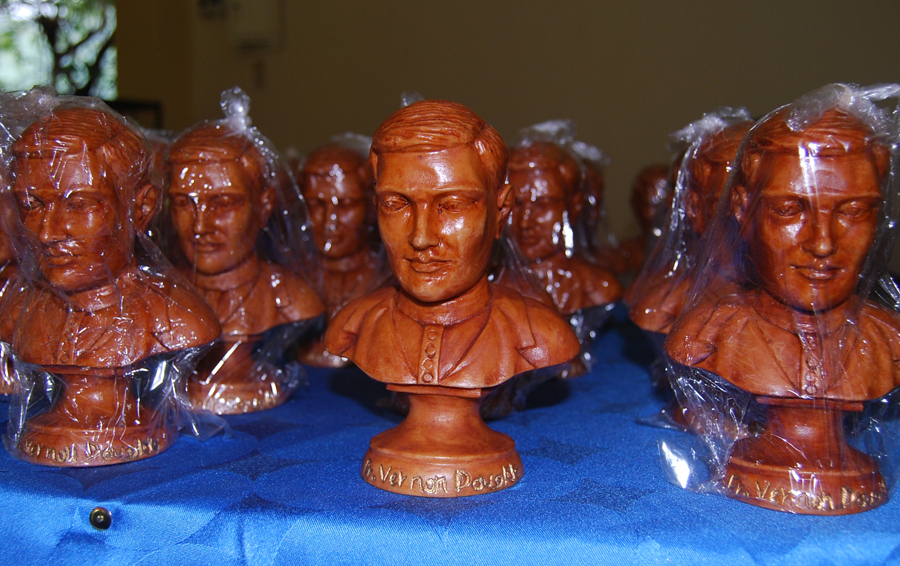
Bust of Fr Vernon Douglas, Paete, Laguna
Paete is noted for its woodcarvings
On 28 September, as you can read in this issue, a large group of those involved in the mission of the Columbans in the Philippines and elsewhere, and four very special visitors from New Zealand, went on a pilgrimage to two places particularly associated with Columban Fr Francis Vernon Douglas: Pililla, Rizal, with his life, and Paete, Laguna, with his torture and death at the hands of the Japanese in 1943. Like the original Columban priests, Fr Douglas was already a diocesan priest, of the Archdiocese of Wellington, when he joined the Society in 1938. Like many other Columbans he met a violent end, in the service of Jesus Christ and his people. Like Jesus, he was scourged at a pillar and was 33 when he died.
In his closing homily on 17 August 2014 at Asian Youth Day in Korea, where Columbans have worked since 1933, Pope Francis said, You are the heirs of a great testimony, a precious witness to Christ. Part of that testimony for us is the sacrifice of Fr Douglas. Pray for all our younger Columban priests, seminarians and lay missionaries that they may take those words of the Pope to heart along with what he said later in his homily: You are not only a part of the future of the Church; you are also a necessary and beloved part of the Church’s present!
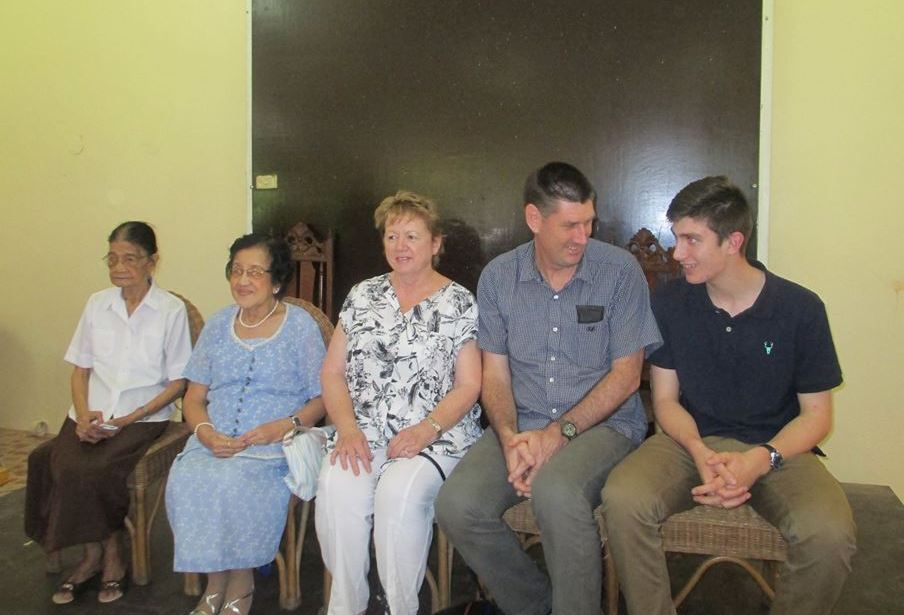
L to R: Miss Dominga Bayocot, Mrs Aurelia Cadapan with Fr Douglas’s relatives in Paete, Mrs Verne Turner, her cousin Vernon Douglas and his son Brendan
During November we remember the dead in a special way in our prayers. Please pray for the soul of Mrs Aurelia ‘Auring’ Cadapan of Paete, one of the two witnesses to the sufferings of Fr Douglas who spoke to us during the pilgrimage to Pililla and Paete on 28 September, the other being Miss Dominga Bayocot. She died a few weeks later, aged 88. Her ‘family and neighbors shared that Aurelia was full of great joy these last weeks and was so pleased that the pilgrimage had happened’. May she rest in peace.
Sabbatical for Future Commitment
By John B. Din
The author is from San Miguel, Zamboanga del Sur. In 1993 he went as a Columban Lay Missionary to Brazil where he spent seven years before being assigned to Peru. In 2011 he was appointed Coordinator of the Columban Lay Missionaries in the Philippines. Last year, after his sabbatical year, he was appointed Regional JPIC (Justice, Peace and Integrity of Creation) Coordinator and is based in Quezon City.
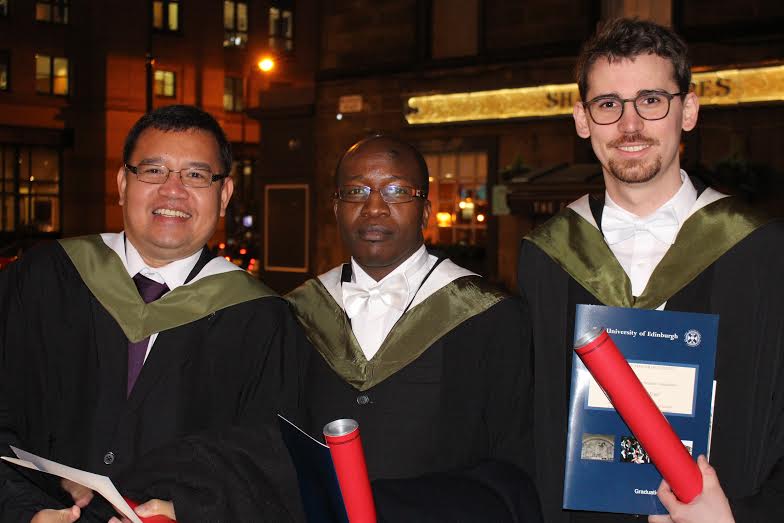
John Din (left) and friends at graduation, University of Edinburgh 2015
In his book The Light Which Deems the Stars the late Columban Fr Colm McKeating, who worked in the Philippines for many years, argues that the sabbatical is the climax of creation and includes the care and protection of every creature because they all belong to God. Thus a sabbatical year is a not about rest and idleness but is rather meant to be an active and intense experience of God who is the ground of our existence. Indeed, it is about breaking with routine and the familiar and uncovering the extraordinary behind the veil of everyday experience. It is amazing how a different kind of work can reinvigorate when it fits the desire of the spirit.
After more than twenty years of being a Columban Lay Missionary, I spent my sabbatical studying for a Master’s degree in Science and Religion at the University of Edinburgh, Scotland, the sixth oldest university in the English-speaking world. I had planned to start with a Thirty-day Retreat (The Spiritual Exercises of St Ignatius of Loyola).
Unfortunately, due to a problem getting a visa, I had to forego the retreat and start my formal studies directly.
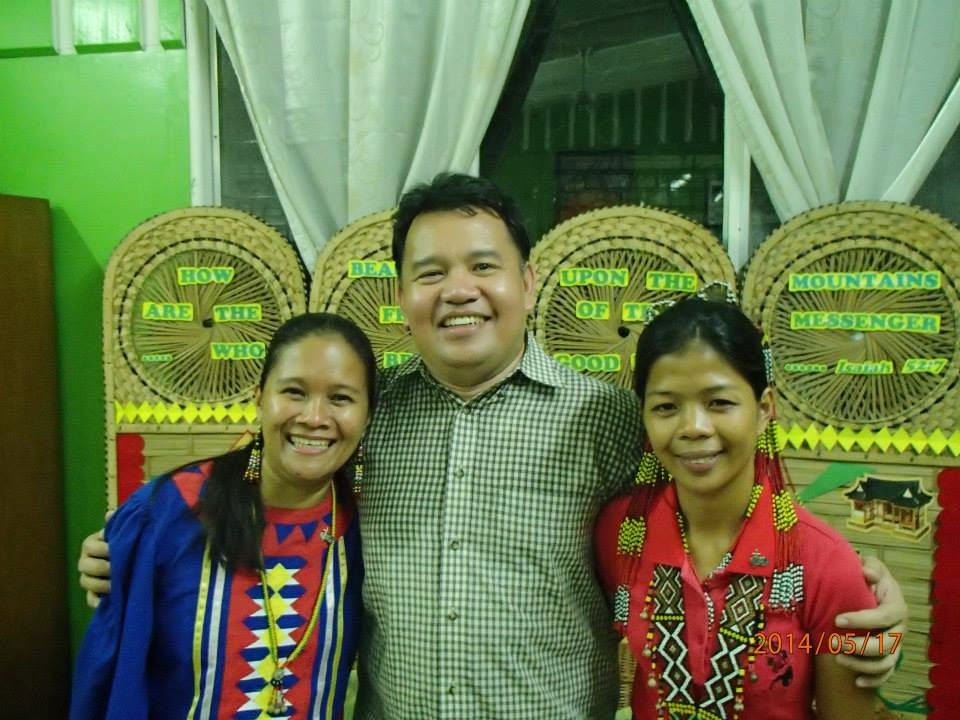
John Din at mission-sending of Luda Egbalic and Jenanydel Nola, now in Korea, 2014
I tried to combine reflection on my own experience with the demands of study. I wrote essays about suffering and evil, drawing from my experience in dealing with schizophrenia in the family as well as science and indigenous wisdom relating to the struggle of the Subanen people in Midsalip, Zamboanga del Sur, against extractive industries. It was my way of pulling together the experiential and the theoretical and discovering how they enrich each other. It was a form of self-confrontation, questioning my assumptions, beliefs and hopes.
I decided to study science and religion because I felt the need to have a good grasp of science after seeing through my engagement with different groups, NGOs and civil society, how it has strengthened the argument about climate change. In this age where facts and proofs determine the validity of an argument science can challenge us by questioning our assumptions and presumptions.
Science has shown us the evolutionary nature of the development of our universe since 13.7 billion years ago. It shows the dynamic and continuous creativity present in creation. Contrary to the perceived conflict narrative of science and religion, which is an invention of the nineteenth century, history provide a dynamic relation between science and religion. For example, the long-held belief of indigenous peoples around the world that everything is interconnected is affirmed by both evolution and quantum theories. Both affirm the dynamism and uncertainty in reality. Thus, our deeper understanding of the changing face of God our Creator as we reflect on our life experiences over the years is a healthy indicator that we are indeed relating to a living God.
Three Columban half-marathon runners, Peru 2011: Fr Bernie Lane (Australia), John Din, Fr Tony Coney (Ireland)
I felt I was plunged into hard science since I had to explore and deal with two particular persons who were both religious and scientists. My dissertation discussed how science and mysticism inform each other, focusing on the lives of Fr Pierre Teilhard de Chardin SJ (1881-1955) and Arthur Stanley Eddington (1882-1944), a Quaker. In exploring the life of Teilhard I had to research his views and grapple with evolution. With Eddington, I had to deal with his general relativity and quantum theory. I found myself struggling to grasp three major breakthroughs in the nineteenth and twentieth centuries.
While writing my dissertation my desire for the Thirty-day Retreat was reawakened, after reading the life of Teilhard. The Spiritual Exercises helped him deal with the apparent contradiction of loving God and loving the world. There is a big difference between studying the Spiritual Exercises and doing the retreat itself. Having now been through the Exercises, I can understand better the struggle of Teilhard and how he came to his own synthesis of the apparent contradiction. Later I realized how my study led me back to the Thirty-day Retreat. This is my experience of how the study of science leads one to the Divine.
Gratitude was the dominant feeling during the retreat: gratefulness for God’s faithfulness through the many people I met in Brazil, Peru and the Philippines; many are unknown to me and known only to God.
John Din with staff of the Happy Earthworm Ecology Project, Peru
Now I am back in the Philippines and have been appointed Regional JPIC Coordinator. I am looking forward to the fruits of my sabbatical study and life experience in Brazil, Peru and the Philippines as a Columban Lay Missionary. The door is open for surprises, an attitude proper to a reality that is dynamic and infused with the divine. One of the pleasant surprises is Laudato Si’, the encyclical letter of Pope Francis ‘On care for our common home’, because it calls for a deeper understanding of who we are in the light of recent contributions from science and the current ecological crisis that we are facing. I am very grateful to the Columbans, priests and lay missionaries, as well as benefactors for this opportunity to get away from the routine and engage in an active resting.
The Philippine War On Drugs
By Fr John Keenan
The author is from Ireland and first came to the Philippines in 1966. He is based in Manila.
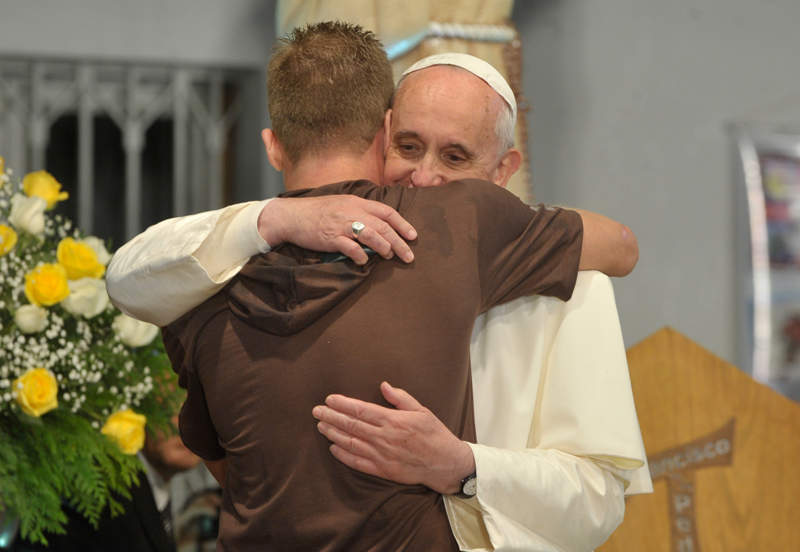
Pope Francis with a recovering drug addict
St Francis of Assisi of the Providence of God Hospital, Rio de Janeiro, 24 July 2013 [Wikipedia]
‘To all of you, I repeat: Do not let yourselves be robbed of hope! Do not let yourselves be robbed of hope! And not only that, but I say to us all: let us not rob others of hope, let us become bearers of hope!’ (Pope Francis, 24 July 2013, Rio de Janeiro).
The war on drugs initiated by President Rodrigo R. Duterte on 1 July 2016 has made headlines around the world. The Fifth Commandment, ‘You shall not kill’, is ignored. Most of the extra judicial killings take place among the poor. Even women are killed. Children also are caught in cross-fire.
I celebrate Mass in a shanty-town in Manila every Sunday morning. After our Mass on 16 October I was invited to bless a house. Filipinos will not sleep in a house where a murder has been committed until it has been blessed. We proceeded along the narrow pathways in the shanty town. Towards the end I was led through a narrow passageway leading to very narrow stairs, which were difficult for me to climb, up to a small room. The couple living there told me that their brother had been shot dead. He slept on plywood in a corner of the shack. A policeman had made his way up the narrow stairs and shot him at close range. Such incidents are all too common in the on-going war against drugs, especially in poor areas.
Since the new government took over on 30 June, some 3,750 have been summarily executed, as of late October. (Another source gives a figure of 2,210). They were suspected of being drug addicts or drug-pushers and denied the due process that was their right. I was asked to bless another home where the man of the house was similarly shot dead as he rested. His wife showed me their small baby. It was a two-storey rickety shack. The wake was held on the street, since the shack was too small for the coffin. Afterwards the woman living downstairs asked me to bless her room. She pointed out to me the ceiling-boards where the victim’s blood had trickled down.
Another woman talked about how her husband was shot in front of their children. He pleaded to be allowed to kiss his children goodbye. This was denied. He was taken outside and summarily executed.
Pope Francis visits a drug rehabilitation center
Rome, 26 February 2016
Even when people surrender they are shot dead in the on-going sustained war on drugs. To add insult to injury, poor people have to raise funds to bury their murdered loved ones. In this Year of Mercy the killing goes on without mercy. The appeals of human rights groups, of the USA, the European Union, the International Criminal Court, to end the summary executions are ignored. The aim is to kill three million!
The root cause of drug addiction is poverty. Many children cannot go to school, remain illiterate, can find no employment and so become involved in the drug trade in order to survive.
Some live on the streets, others in inhumane conditions in one-roomed shacks. They sniff glue and ‘shabu’ to assuage the pangs of hunger because there are no concrete programs to address the problems of unemployment, inadequate housing, lack of subsidised food and education for the poor.
The human cost of the war on drugs is enormous. Families are devastated. Communities are infiltrated by spies and informers. Many become widows and orphans. Even women are killed either by police or vigilante groups. One woman was hired by her husband to become a killer. Not being a suspected killer she can move in and kill at close range. She has already killed six. She regrets what she has done as she herself has children. If she quits her bloody job she fears that she too will be killed.
In theory, suspected drug users are given the choice of surrendering or of being shot. Often those who surrender are shot dead. If not, they are imprisoned in inhumane, over-crowded jails. They are supposed to go to rehabilitation centers, which are few and far between. There is a serious shortage of doctors, nurses and trained counselors to help addicts to recover. They are sick people in need of healing from their addictions, not criminals to be shot on sight.
Church people are being asked to help in the rehabilitation process but they are unprepared for the huge numbers.
The killing must stop and the victims of drug addiction must be given a chance to recover and rebuild their lives. That is their basic human right. Unless the government changes its policy, the killing will continue and we’ll have many more destitute widows and orphans. There must be another way to deal with the drug menace. Hope springs eternal. The people deserve better.
+++
Pope Francis visits St Francis of Assisi of the Providence of God Hospital
Rio de Janeiro, 24 July 2013
‘Today, in this place where people struggle with drug addiction, I wish to embrace each and every one of you, who are the flesh of Christ, and to ask God to renew your journey, and also mine, with purpose and steadfast hope.’ Pope Francis.
You will find the Pope’s full talk on the Vatican website here.
Pope Francis in Rio de Janeiro, 26 July 2013
‘Father, have you heard this joke before?’
By Fr Bernard McDermott

Fr John Blowick as a young priest
Fr John Blowick, the Co-founder with Fr Edward Galvin of the Columbans, said that the pennies of the poor were more important than the pounds of the wealthy, though he welcomed both. The Columbans have been blessed with generous benefactors, both poor and rich, down the years and here in the Philippines we are moving towards being self-supporting through such support. Fr Bernard McDermott, from Manchester, England, was ordained in 1974 and spent the early years of his priesthood in Mindanao. He is now based in Britain where he has served as Regional Director. The story of Frank Joyce, which first appeared in the September 2016 issue of The Far East, the Columban magazine in Australia and New Zealand, is the story, with different details, of all who have supported us Columbans in our mission down through the years.

Street scene, Govan, Glasgow [Wikipedia]
I will always remember the letters from Frank Joyce a loyal supporter of the Columbans from Govan in Glasgow, Scotland, because he always wrote a joke as part of his letter. He also enclosed a substantial cash donation each time which came from his meager pension.
The office staff here at Solihull, England, thought it appropriate that the Regional Director should reply to Frank's letters and I was happy to do that. Through our correspondence we became great friends over the few years I knew him. I eventually persuaded him to allow his niece to write a check on his behalf as sending cash through the mail was a quite a risk. I was always under pressure when I replied to include 'a joke'.
On one occasion when I was in Glasgow visiting my Columban colleagues I went to visit Frank at his home in a tenement flat in Govan. The day I called I got no reply but his neighbor informed me that Frank was quite deaf and suggested I leave a note for him to say I would call maybe the next morning.
I did this and returned the following morning to find the front door open. I called out and walked into his small living room (sala) where I met Frank. He sat in a wheelchair with a few pieces of furniture around him including a small table covered with a lovely white table cloth with cups, saucers, milk and sugar etc . . . all set for a party!

Crusader tank, used by the British Army in El Alamein [Wikipedia]
Frank had no legs! He told me he was in a tank regiment during World War Two and in one of the two Battles of Alamein, Egypt, in 1942 his tank was hit by a shell and he was badly injured. He had adopted the Columbans as his favorite charity after a mission appeal from one of our priests some years before and had continued to support us with regular donations from his pension.
I gave Frank a special blessing before I left and felt that I had received as much from the visit, if not more, as Frank had, as he was clearly delighted to greet me . . . you would have thought it was the Pope who had called!! We had a lovely visit and I felt privileged to be in the company of a very special man.
Frank died some time later and I, together with two other Columbans and the parish priest, celebrated his Requiem Mass in his parish church, St Anthony’s, in Govan.

St Anthony’s Church, Govan [Source]
Some weeks later I received a letter from the manager of Barclays Bank enclosing a check for £1500 (more than Php90,000 in today’s money) for the Columban mission. It was a final gift from Frank Joyce and was the total sum left in his bank account. May he rest in peace.
I felt it a privilege to have known Frank Joyce and his example of generosity is typical of many of our loyal Columban supporters who are remembered daily in our Masses and prayers.
The Wikipedia article on Govan says, ‘According to medieval legend, Constantine, a 7th-century King of Strathclyde, founded a monastery under the rule of Columbanus (St Columban) in Govan.’
Lili Marleen
The Germans broadcast to all their soldiers in Europe and North Africa during World War II from Belgrade, then the capital of Yugoslavia, now the capital of Serbia. The station signed off each night with a love song about a soldier and his girlfriend, Lili Marleen. It was not a propaganda song and the German Minister for Propaganda, Joseph Goebbels, tried to ban it. It became a great favorite not only with the Germans in North Africa but with the Allied troops as well. The song was translated into many languages, including English. But the version that Frank Joyce and his companions first got to know in El Alamein was the original recording in German by Lale Anderson.
|
